包装盒专业英语5
常见包装英语大全定稿版

常见包装英语大全HUA system office room 【HUA16H-TTMS2A-HUAS8Q8-HUAH1688】常见包装英语大全aluminumBottle铝瓶amp(o)ule安瓿(药针支)bale捆,包balecargocapacity包装容积balesoff散包basket笼、篓、篮、筐block块bobbin绕线筒bolt(piece)匹Bottle瓶bundle(Bd)捆(包装单位)bottom下端,底部,底层braid瓣bundle捆cartridgecontainer尾管case(-s)一件(货物/行李) casing套(罩)container集装箱,盂,箱copperPot铜壶degree度denominator分母depth深度dozen打drum桶fraction分数gross箩hard硬的height高度intheformofafraction分数形式kilogram公斤length长度nailedon钉上numerator分子package一件(货物/行李) piece件、支、把、个ream捻,令roll(reel)卷set(kit)架、台、套sharp锋利的sideofacase箱子的一面thick厚thickness厚度unit(cart)辆watertight水密width宽度yard码packingmaterial包装材料adhesivetape压敏胶带backing缓冲衬板bales包件bamboobatten竹条bambooskin竹篾batten狭木条bituminousKraftpaper地沥青牛皮纸brasswire铜丝buckle扣箍buffer缓冲材料bulrushmat蒲、苇bypattern,bystencil按图安板canvascloth防水布,粗帆布canvassheet防水布,粗帆布cardboardpaper厚板纸cargocompressor货用压缩机cargolashingchain货物捆绑链cellophane玻璃纸cloth,canvas粗麻布coatedpaper涂层纸containerloader装箱机,集装箱装箱机containermouldingapparatus容器成型装置containersealingcompound容器封口胶compressedgas压缩气体containerboar盒纸板containerboard盒纸板containermaterial容器材料cord绳子,绳索cushioningmaterial衬垫材料film薄膜,胶片filmmembrane薄膜FlexibleContainer集装包/集装袋foamedplastics泡沫塑料foamedrubber泡沫橡胶foamplasticbag泡沫塑料袋foil箔纸heatseal热封口indeliblepaint不褪色的涂料,耐洗涂料ironRod铁条ironWire铁丝Kraftpaper牛皮纸leadPot铅壶metalstrap铁箍metaltag金属标牌nonreturnablecontainer一次用包装oldgunnybag旧麻袋packet(pkt.)包裹,封套,袋packingcase包装箱,包装件packingcloth,packingcanvas包装用的粗麻布packingcord包装用的细绳packingpaper包装纸packingstring包装用的绳子,运单packing,package包装,包装材料packingsupplies包装材料paint颜料,油漆,涂料pallet托盘pallet卡板palletizer堆卡板机paper纸paperscrap纸屑paperslip纸条papertag纸标签papertape纸带paperwool纸层paperboard纸板partition隔板patter,template,stencil图案板plasticfoam泡沫塑料plywood胶合板polyfoam(snowbox)保丽龙(泡沫塑料)polyethylenefilm聚乙烯薄膜polythene聚乙烯preservative防腐剂presspackedbale紧压包reusabletare多次使用的包皮satin-covered缎包装的seal封口second-handcase用过的箱子silkribbon绸带singlesoundbag单层完整袋子sizeofacase箱子的大小strap带,铁皮带stapleU型钉stencil印上油墨tarpaulin防水布,粗帆布throwawaytare不能继续使用的包皮transparentpaper透明纸twine,string,packthread绳子,绳索. usedgunnybag旧麻袋vial玻璃小瓶kindofpacking包装种类bagcontainerpacking集装袋装bareinloose裸装can罐装,听装cardboardpackage硬纸盒包装collectivepacking组合包装containerpacking集装箱装consumerpacking消费包装customarypacking普通包装,习惯包装flexiblecontainerpacking集装包装/集装袋装flexiblepackage软包装hingecovercontainer挂式包装homogeneouscargobaggedforstowagepurpose同类散货压舱包装,同类散货袋用压包inaluminumfoilpacking铝箔包装inblock块装inbulk散装inbundle捆(扎)装innerpacking内包装,小包装innude裸装inslice片装inspear条装interiorpackaging内部包装moistureproofpackaging防潮包装neutralpacking中性包装nudeparched裸装outerpackage外包装outerpacking大包装,外包装packingexterior外部包装packingforexportgoods出口商品(货物)的包装packinginterior内部包装packingofnominatedbrand定牌包装palletizing托盘包装paperpacking纸包装plasticpacking塑料包装prepackaging预包装regularpackingforexport正规出口包装rustproofpackaging防锈包装salespackage销售包装,内包装seaworthypacking海运包装sellersusualpacking卖方习惯包装singlepacking单件包装shipmentpacking运输包装shockproofpackaging防震包装tin罐装,听装transparentpackage透明包装transportpackage运输包装tropicalpacking适应热带气候的包装unpacked散装vacuumpackaging真空包装waterproofpackaging防水包装waterproofpacking防水包装(材料),不透水包装withoutpacking裸装outerpacking大包装,外包装。
包装专业术语
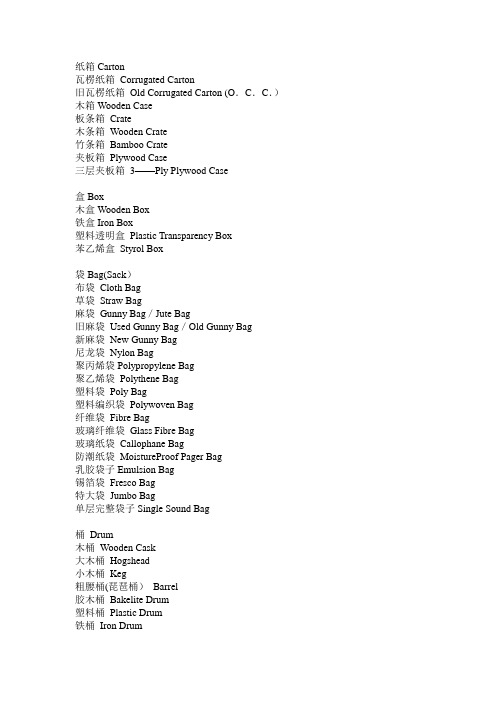
纸箱Carton瓦楞纸箱Corrugated Carton旧瓦楞纸箱Old Corrugated Carton (O.C.C.)木箱Wooden Case板条箱Crate木条箱Wooden Crate竹条箱Bamboo Crate夹板箱Plywood Case三层夹板箱3——Ply Plywood Case盒Box木盒Wooden Box铁盒Iron Box塑料透明盒Plastic Transparency Box苯乙烯盒Styrol Box袋Bag(Sack)布袋Cloth Bag草袋Straw Bag麻袋Gunny Bag/Jute Bag旧麻袋Used Gunny Bag/Old Gunny Bag新麻袋New Gunny Bag尼龙袋Nylon Bag聚丙烯袋Polypropylene Bag聚乙烯袋Polythene Bag塑料袋Poly Bag塑料编织袋Polywoven Bag纤维袋Fibre Bag玻璃纤维袋Glass Fibre Bag玻璃纸袋Callophane Bag防潮纸袋MoistureProof Pager Bag乳胶袋子Emulsion Bag锡箔袋Fresco Bag特大袋Jumbo Bag单层完整袋子Single Sound Bag桶Drum木桶Wooden Cask大木桶Hogshead小木桶Keg粗腰桶(琵琶桶)Barrel胶木桶Bakelite Drum塑料桶Plastic Drum铁桶Iron Drum镀锌铁桶Galvanized Iron Drum镀锌闭口钢桶Galvanized Mouth Closed Steel Drum 镀锌开口钢桶Galvanized Mouth Opened Steel Drum 铝桶Aluminum Drum麻布包Gunny Bale(Hessian Cloth Bag)蒲包Mat Bale草包Straw Bale紧压包Press Packed Bale铝箔包Aluminium Foil Package铁机包Hard—pressed Bale木机包Half—pressed Bale缸Jar陶缸Earthen Jar瓷缸Porcelain Jar壶Pot铅壶Lead Pot铜壶Copper Pot瓶Bottle铝瓶Aluminum Bottle陶瓶Earthen Bottle瓷瓶Porcelain bottle罐Can听Tin绕线筒Bobbin笼(篓、篮、筐)Basket竹笼(篓、篮、筐)Bamboo Basket柳条筐(笼、篮、筐)WickerBasket集装箱Container集装包/集装袋Flexible Container整箱FCL full container load拼柜LCL less than container load散货CCL托盘Pallet件(支、把、个)Piece架(台、套)Set(Kit)安瓿Amp(o)ule(药针支)双Pair打Dozen令Ream匹Bolt(Piece)码Yard卷(Roll(reel)块Block捆Bundle瓣Braid度Degree辆Unit(Cart)套(罩)Casing包装形状Shapes of Packing圆形Round方形Square三角形Triangular(DeltaType)长方形(矩形)Rectangular菱形(斜方形)Rhombus(Diamond) 椭圆形Oval圆锥形Conical圆柱形Cylindrical蛋形Egg—Shaped葫芦形Pear—Shaped五边形Pentagon六边形Hexagon七边形Heptagon八边形Octagon长Long宽Wide高High深Deep厚Thick长度Length宽度Width高度Height深度Depth厚度Thickness包装外表标志Marks On Packing下端,底部Bottom顶部(上部) Top(Upper)小心Care勿掷Don’t Cast易碎Fragile小心轻放,小心装运Handle With Care 起吊点(此处起吊)Heave Here易燃物,避火Inflammable保持干燥,防潮KeepDry防潮keep Away from Moisture储存阴冷处Keep in a Cool Place储存干燥处Keep ina Dry Place避火Inflammable避冷To be Protectedfrom Cold避热To be Protected from Heat在滚子上移动Use Rollers此方向上ThisSide Up由此开启Open from This Side爆炸品Explosive遇水燃烧品Dangerous When Wet有毒品Poison无毒品No Poison不可触摩Hand off适合海运包装Seaworthy Packing毛重Gross Weight (Gr。
包装行业工艺术语英语词汇
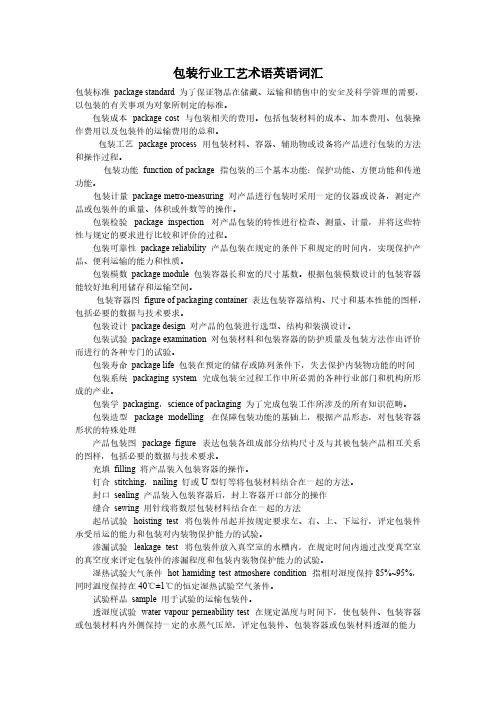
包装行业工艺术语英语词汇包装标准package standard 为了保证物品在储藏、运输和销售中的安全及科学管理的需要,以包装的有关事项为对象所制定的标准。
包装成本package cost 与包装相关的费用。
包括包装材料的成本、加本费用、包装操作费用以及包装件的运输费用的总和。
包装工艺package process 用包装材料、容器、辅助物或设备将产品进行包装的方法和操作过程。
包装功能function of package 指包装的三个基本功能:保护功能、方便功能和传递功能。
包装计量package metro-measuring 对产品进行包装时采用一定的仪器或设备,测定产品或包装件的重量、体积或件数等的操作。
包装检验package inspection 对产品包装的特性进行检查、测量、计量,并将这些特性与规定的要求进行比较和评价的过程。
包装可靠性package reliability 产品包装在规定的条件下和规定的时间内,实现保护产品、便利运输的能力和性质。
包装模数package module 包装容器长和宽的尺寸基数。
根据包装模数设计的包装容器能较好地利用储存和运输空间。
包装容器图figure of packaging container 表达包装容器结构、尺寸和基本性能的图样,包括必要的数据与技术要求。
包装设计package design 对产品的包装进行选型、结构和装潢设计。
包装试验package examination 对包装材料和包装容器的防护质量及包装方法作出评价而进行的各种专门的试验。
包装寿命package life 包装在预定的储存或陈列条件下,失去保护内装物功能的时间 包装系统packaging system 完成包装全过程工作中所必需的各种行业部门和机构所形成的产业。
包装学packaging,science of packaging 为了完成包装工作所涉及的所有知识范畴。
食品包装的专业英语
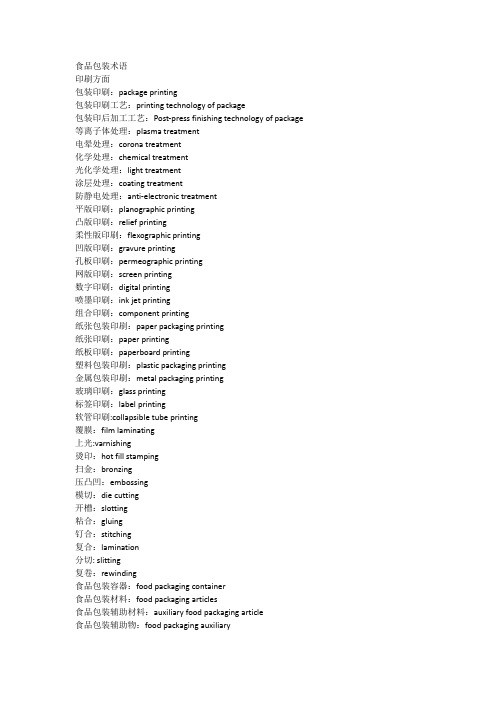
食品包装术语印刷方面包装印刷:package printing包装印刷工艺:printing technology of package包装印后加工工艺:Post-press finishing technology of package 等离子体处理:plasma treatment电晕处理:corona treatment化学处理:chemical treatment光化学处理:light treatment涂层处理:coating treatment防静电处理:anti-electronic treatment平版印刷:planographic printing凸版印刷:relief printing柔性版印刷:flexographic printing凹版印刷:gravure printing孔板印刷:permeographic printing网版印刷:screen printing数字印刷:digital printing喷墨印刷:ink jet printing组合印刷:component printing纸张包装印刷:paper packaging printing纸张印刷:paper printing纸板印刷:paperboard printing塑料包装印刷:plastic packaging printing金属包装印刷:metal packaging printing玻璃印刷:glass printing标签印刷:label printing软管印刷:collapsible tube printing覆膜:film laminating上光:varnishing烫印:hot fill stamping扫金:bronzing压凸凹:embossing模切:die cutting开槽:slotting粘合:gluing钉合:stitching复合:lamination分切: slitting复卷:rewinding食品包装容器:food packaging container食品包装材料:food packaging articles食品包装辅助材料:auxiliary food packaging article食品包装辅助物:food packaging auxiliary塑料包装容器:Plastic container塑料箱:Plastic bin塑料周转箱:Plastic circulating bin钙塑瓦楞箱:Plastic calp bin塑料保温箱:Plastic heat insulated bin塑料杯:Plastic bottle塑料袋:Plastic bag非复合薄膜袋:Single-ply film bag复合薄膜袋:Laminated film bag塑料编织袋:Plastic woven bag复合塑料编织袋:Laminated plastic woven bag 塑料杯:Plastic cup塑料盘:plastic plate塑料盒:Plastic box塑料桶:Plastic drum塑料罐:plastic can塑料盆:plastic bin塑料筐:plastic basket纸包装容器:Paper container纸袋:Paper bag纸盒:Carton折叠纸盒:Folding carton固定纸盒:Fixed carton淋膜纸盒:Coated paper carton纸杯:paper cup纸罐: paper can纸餐具:Paper-made dishware玻璃包装容器:glass container玻璃杯:glass jar复合罐:Composite canister复合盒:Composite box复合袋:Composite bag陶瓷包装容器:ceramic package vessel陶器:Pottery vessel瓷器:porcelain金属包装容器;metal container金属罐:metal can两片罐:two- piece can三片罐:three-piece can金属桶:metal bucket金属盒:metal carton铝箔容器:Aluminum foil container木质包装容器:Wooden container木箱:wooden case木盒;wooden box木桶:wooden barrel竹材包装容器:bamboo container草类编织容器:grass woven container搪瓷容器:enamel container纤维容器:Fiber-made container布袋:fabric bag麻袋:jute bag人造纤维袋:artificial fiber bag合成纤维袋:Synthetic fiber bag塑料包装材料:plastic packing article塑料膜:plastic film非复合塑料膜:single-ply film复合塑料膜:laminated film食品保鲜膜:cling film for food wrapping 塑料肠衣膜:sausage casing塑料片:plastic sheet纸包装材料:paper wrapping article玻璃纸:cellophane半透明纸:transluent paper食品羊皮纸:parchment for food茶叶袋滤纸:filter paper for teabag鸡皮纸:cartridge paper铝箔:aluminum foil油墨:printing ink密封物:Closure material软木塞:Cork plug密封垫:Closure liner迁移:Migration迁移量:Migration quantity总迁移限量:Overall migration limit特定迁移限量:Specific migration limit残留;Residual最大残留限量:Maximum residue limit蒸发残渣:Evaporation residue重金属迁移量:Heavy metal migration limit 荧光性物质:Fluorescent substances脱色:decolorization急性毒性试验:Acute toxicity test亚慢性毒性试验:subacute toxicity test慢性毒性试验:Chronic toxicity test可追溯性:Traceability运输包装:transport package工业包装:industrial package销售包装:consumer package商业包装:commercial package硬质包装:rigid package软包装:flexible package内状物:contents透明包装:transparent package可折叠包装:collapsible package可拆卸包装:discountable package便携包装:carrier pack系列包装;series package配套包装:set package局部包装:part package避开包装:open package托盘包装:palletizing packaging捆扎包装:strapping package盘卷包装;drum package单元货物:unit loads危险品包装:dangerous goods package散伙包装:bulk packaging集合包装:assembly packaging过度包装:overpackaging适度包装:appropriate packaging初始包装:original package儿童防护包装:child-resistant package单体包装:individual packaging多层包装:multi-pack一次性包装:portion package可重复利用容器:returnable container环保包装:environmentally conscious packaging 无菌包装:aseptic packaging配送包装:distribution packaging包装模数:package module包装系统:packaging system包装功能:function of package包装设计:package design包装工艺:package process包装机械:packaging machinery填充机:filling machine封口机:sealing machine裹包机:wrapping machine标签机:labeling machine清洗机:cleaning machine干燥机:drying machine杀菌机: sterilization machine捆扎机:strapping machine集装机:machine for the assembly of unit load防护包装:protective packaging防水包装:water proof packaging防潮包装:moistureproof packaging防霉包装:mouldproof packaging防静电包装:electrostaticsproof packaging防锈包装:rustproof packaging缓冲包装:cushioning packaging防磁包装:magnetic field-resistant packaging防辐射包装:Radiation resistant packaging防虫包装:insect-resistant packaging再生材料:recovered materials木质包装:Wooden packaging寿命周期分析:life cycle assessment胶带:gummed tape护棱:edge protector护角:corner protector包装检验:package inspection包装试验:package test压力试验:compression test堆码试验:stacking test跌落试验:drop test垂直冲击试验:vertical impact test危险物冲击试验:Hazard impact test集中冲击试验:concentrated impact test重复冲击试验:repetitive shock test水平冲击试验:horizontal impact test斜面冲击试验:incline impact test掉摆试验:pendulum test可控水平冲击试验:controlled horizontal impact test 碰撞试验:Bump test滚动试验:Rolling test振动试验:Vibration test定频振动试验:Constant frequency vibration test变频振动试验:Variable frequency vibration test随机振动试验:Random vibration test车辆模拟振动试验:Vehicle simulate vibration test 起吊试验:Hoisting test倾翻试验:Toppling test单元货物稳定性试验:Unit loads stability test夹紧搬运试验:Clamp handle test耐候试验:Weather resistance test高温试验:High temperature test低温试验:Low temperature test湿温度交变试验:Temperature and humidity alternate change test 湿温度冲击试验:Temperature and humidity rapid change test风淋试验:Wind and rain test浸水试验:Water immersion test渗漏试验:Leakage test长霉试验:Mould growth test透水性试验:Water permeability test气密试验:Air-tight test液压试验:Hydraulic test加载装置:Exert load set喷淋装置:Water spray set冲击台:impact table定量数据:Quantitative data无菌装置:Aseptic packaging湿度指示卡:Humidity indicator card气相缓冲剂:Volatile Corrosion Inhibitor可剥性塑料:Strippable plastics包装组分:packaging component包装成分:packaging constituent生物降解:biodegradation化学分解:chemical degradation光降解:Photo degradation机械分解:mechanical degradation热降解:Thermal degradation堆肥:Compost主要燃料:Principal fuel次要燃料:Secondary fuel维持燃料:Support fuel垃圾燃料:Refuse derived fuel(注:可编辑下载,若有不当之处,请指正,谢谢!)。
食品包装的专业英语
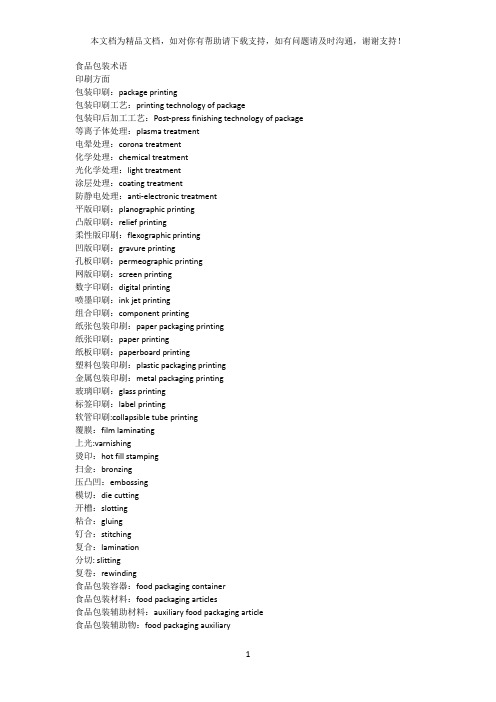
食品包装术语印刷方面包装印刷:package printing包装印刷工艺:printing technology of package包装印后加工工艺:Post-press finishing technology of package 等离子体处理:plasma treatment电晕处理:corona treatment化学处理:chemical treatment光化学处理:light treatment涂层处理:coating treatment防静电处理:anti-electronic treatment平版印刷:planographic printing凸版印刷:relief printing柔性版印刷:flexographic printing凹版印刷:gravure printing孔板印刷:permeographic printing网版印刷:screen printing数字印刷:digital printing喷墨印刷:ink jet printing组合印刷:component printing纸张包装印刷:paper packaging printing纸张印刷:paper printing纸板印刷:paperboard printing塑料包装印刷:plastic packaging printing金属包装印刷:metal packaging printing玻璃印刷:glass printing标签印刷:label printing软管印刷:collapsible tube printing覆膜:film laminating上光:varnishing烫印:hot fill stamping扫金:bronzing压凸凹:embossing模切:die cutting开槽:slotting粘合:gluing钉合:stitching复合:lamination分切: slitting复卷:rewinding食品包装容器:food packaging container食品包装材料:food packaging articles食品包装辅助材料:auxiliary food packaging article食品包装辅助物:food packaging auxiliary塑料包装容器:Plastic container塑料箱:Plastic bin塑料周转箱:Plastic circulating bin钙塑瓦楞箱:Plastic calp bin塑料保温箱:Plastic heat insulated bin塑料杯:Plastic bottle塑料袋:Plastic bag非复合薄膜袋:Single-ply film bag复合薄膜袋:Laminated film bag塑料编织袋:Plastic woven bag复合塑料编织袋:Laminated plastic woven bag 塑料杯:Plastic cup塑料盘:plastic plate塑料盒:Plastic box塑料桶:Plastic drum塑料罐:plastic can塑料盆:plastic bin塑料筐:plastic basket纸包装容器:Paper container纸袋:Paper bag纸盒:Carton折叠纸盒:Folding carton固定纸盒:Fixed carton淋膜纸盒:Coated paper carton纸杯:paper cup纸罐: paper can纸餐具:Paper-made dishware玻璃包装容器:glass container玻璃杯:glass jar复合罐:Composite canister复合盒:Composite box复合袋:Composite bag陶瓷包装容器:ceramic package vessel陶器:Pottery vessel瓷器:porcelain金属包装容器;metal container金属罐:metal can两片罐:two- piece can三片罐:three-piece can金属桶:metal bucket金属盒:metal carton铝箔容器:Aluminum foil container木质包装容器:Wooden container木箱:wooden case木盒;wooden box木桶:wooden barrel竹材包装容器:bamboo container草类编织容器:grass woven container搪瓷容器:enamel container纤维容器:Fiber-made container布袋:fabric bag麻袋:jute bag人造纤维袋:artificial fiber bag合成纤维袋:Synthetic fiber bag塑料包装材料:plastic packing article塑料膜:plastic film非复合塑料膜:single-ply film复合塑料膜:laminated film食品保鲜膜:cling film for food wrapping 塑料肠衣膜:sausage casing塑料片:plastic sheet纸包装材料:paper wrapping article玻璃纸:cellophane半透明纸:transluent paper食品羊皮纸:parchment for food茶叶袋滤纸:filter paper for teabag鸡皮纸:cartridge paper铝箔:aluminum foil油墨:printing ink密封物:Closure material软木塞:Cork plug密封垫:Closure liner迁移:Migration迁移量:Migration quantity总迁移限量:Overall migration limit特定迁移限量:Specific migration limit残留;Residual最大残留限量:Maximum residue limit蒸发残渣:Evaporation residue重金属迁移量:Heavy metal migration limit 荧光性物质:Fluorescent substances脱色:decolorization急性毒性试验:Acute toxicity test亚慢性毒性试验:subacute toxicity test慢性毒性试验:Chronic toxicity test可追溯性:Traceability运输包装:transport package工业包装:industrial package销售包装:consumer package商业包装:commercial package硬质包装:rigid package软包装:flexible package内状物:contents透明包装:transparent package可折叠包装:collapsible package可拆卸包装:discountable package便携包装:carrier pack系列包装;series package配套包装:set package局部包装:part package避开包装:open package托盘包装:palletizing packaging捆扎包装:strapping package盘卷包装;drum package单元货物:unit loads危险品包装:dangerous goods package散伙包装:bulk packaging集合包装:assembly packaging过度包装:overpackaging适度包装:appropriate packaging初始包装:original package儿童防护包装:child-resistant package单体包装:individual packaging多层包装:multi-pack一次性包装:portion package可重复利用容器:returnable container环保包装:environmentally conscious packaging 无菌包装:aseptic packaging配送包装:distribution packaging包装模数:package module包装系统:packaging system包装功能:function of package包装设计:package design包装工艺:package process包装机械:packaging machinery填充机:filling machine封口机:sealing machine裹包机:wrapping machine标签机:labeling machine清洗机:cleaning machine干燥机:drying machine杀菌机: sterilization machine捆扎机:strapping machine集装机:machine for the assembly of unit load防护包装:protective packaging防水包装:water proof packaging防潮包装:moistureproof packaging防霉包装:mouldproof packaging防静电包装:electrostaticsproof packaging防锈包装:rustproof packaging缓冲包装:cushioning packaging防磁包装:magnetic field-resistant packaging防辐射包装:Radiation resistant packaging防虫包装:insect-resistant packaging再生材料:recovered materials木质包装:Wooden packaging寿命周期分析:life cycle assessment胶带:gummed tape护棱:edge protector护角:corner protector包装检验:package inspection包装试验:package test压力试验:compression test堆码试验:stacking test跌落试验:drop test垂直冲击试验:vertical impact test危险物冲击试验:Hazard impact test集中冲击试验:concentrated impact test重复冲击试验:repetitive shock test水平冲击试验:horizontal impact test斜面冲击试验:incline impact test掉摆试验:pendulum test可控水平冲击试验:controlled horizontal impact test 碰撞试验:Bump test滚动试验:Rolling test振动试验:Vibration test定频振动试验:Constant frequency vibration test变频振动试验:Variable frequency vibration test随机振动试验:Random vibration test车辆模拟振动试验:Vehicle simulate vibration test 起吊试验:Hoisting test倾翻试验:Toppling test单元货物稳定性试验:Unit loads stability test夹紧搬运试验:Clamp handle test耐候试验:Weather resistance test高温试验:High temperature test低温试验:Low temperature test湿温度交变试验:Temperature and humidity alternate change test 湿温度冲击试验:Temperature and humidity rapid change test风淋试验:Wind and rain test浸水试验:Water immersion test渗漏试验:Leakage test长霉试验:Mould growth test透水性试验:Water permeability test气密试验:Air-tight test液压试验:Hydraulic test加载装置:Exert load set喷淋装置:Water spray set冲击台:impact table定量数据:Quantitative data无菌装置:Aseptic packaging湿度指示卡:Humidity indicator card气相缓冲剂:Volatile Corrosion Inhibitor可剥性塑料:Strippable plastics包装组分:packaging component包装成分:packaging constituent生物降解:biodegradation化学分解:chemical degradation光降解:Photo degradation机械分解:mechanical degradation热降解:Thermal degradation堆肥:Compost主要燃料:Principal fuel次要燃料:Secondary fuel维持燃料:Support fuel垃圾燃料:Refuse derived fuel。
印刷包装行业专业英语

印刷包装行业专业英语形& 书型双扦盒:two tuck end box天地盒:top and base or box with top and bottom lid翻盖盒: lid hinged base with extend flap精品盒: case box or plush box展示盒: display box日历台历calendar信封envelope口袋pocket吸塑:blister or Vac Form咭书:board book (一般表达方式比如为: 5 spreads including cover = 4 spreads + cover = 5 leaves)(并且还有正体portrait和横体landscape 的区别)立体书: Board book binding with pop ups or 3-D structure book游戏拼图puzzles白样dummy 像架,像册photo frame or photo album精装书:case book(一般表达方式比如为: 24 PP or 48PP + case cover )平装书:paper book(一般表达方式比如为: 24 PP or 48PP + cover)记事薄,地址薄: note pad & address book骑钉书:2 wire book(一般表达方式比如为: 24 PP or 48PP + cover)YO书: wire-o or plastic spiral book(一般表达方式比如为: 24 PP or 48PP + cover or case cover) 表面处理coating装订binding光胶gloss lamination植毛flocking边着色painted edge哑胶matte lamination烫金foil stamping精装case making & case in binding水油AQU varnish压纹line embossed平装perfect bounded印油press varnish击凸embossing锁线装section sewnUV UV varnish夜光油glowing dark骑马钉装saddle stitch吸塑油blister varnish隐形油invisible UV车线装singer sewn局部UV spot UV丝印silk screen咭书装card board lamination金粉glittering珍珠油bronzing varnish YO or蛇仔wire-o & plastic spirals环保吸塑ENV heat-seal环保磨光ENV calendering折页paper folding 排咭collate特别UV special UV coating 哑油matte varnish裁切trimed or cutting打孔punch hole 上YO closed in单粉咭: C1S art paper (170gsm) or C1S art board (190gsm -450gsm)胶贴纸: Sticker (85gsm) including removable sticker and permanent sticker 硫油纸: Tracing paper瓦楞纸: Flute or corrugate双灰板: Grey board (350gsm -3500gsm) or Chipboard特种纸: Fancy paper铜版纸: Gloss art paper (80gsm -157gsm)原色牛皮: M/F bleached kraft paper白色牛皮:M/G kraft paper布纹纸: Arlin玻璃咭:Kraft liner board拷贝纸:Tissue paper白腊纸: Max paper再造纸:Recycle board新闻纸: News paper (45-55gsm) or newsprint paper书写纸: Wood free paper (60gsm -120gsm) wood free board(>120gsm)粉灰咭: CCNB board (230gsm -500gsm)无粉咭: Uncoat board(190gsm - 450gsm)双粉咭: C2S art paper(80 -157gsm) or C2S art board (190gsm -450gsm)质量检验英语Die-cuts 啤切Wrong pattern 式样错Trim 切齐/整齐Paint smear 油污Glue joint 胶水贴合/胶水接合点Wrong style 字体错/设计错/类型错Spots /ink picks 污点/脏点Box open joint 爆盒/盒子粘合处分开Streaks 条痕/线条Missing label 标签短少Scratches 擦伤/擦痕Missing print 漏印Upc non-function UPC不良Crease 折痕/弄皱Shadowing 有阴影Indentations 缺口/压痕No glue 无胶水Cracked folds 折叠破裂Glue mark 胶水痕迹Tears 撕破/裂开Poor coating 上光不良Wrong stock NO. 错货号Ink color 墨色Ink density 油墨浓度Glue end flap open 盒开口Seam broken 爆线Water mark 水渍Window detached 爆窗Color mixing 混色Window scratch 胶片擦花Color mismatched 色偏Over softness 太软Dirty 污糟Black white dots 污点(黑白点)Wrong size 尺寸错Cracked damaged 破裂(招致损害)Different color 色偏(颜色不同)Flow mark 水渍痕Poor packing 包装不良Material contaminan 混料(原料污染)Abrasion test fail 磨损测试不合格Glue smear 胶水渍Color run 甩色Poor cutting 裁切不良Wrinkle 皱纹Wrong die cutting 啤切不良Poor forming 折盒不良(外形不同)Scratch 擦痕Wrong grainy cut 裁错纹Glass test fail 光度测试不合格Doubble print 重印(补印)Misc/PVC chips 杂物/胶片破Poor printing 印刷不良Defect sample 样品有缺陷Wrong strippingLinting 纸毛(linty)Color shift 色偏(颜色改变)Misprint 印错,印刷错误Wrong job instruction 开错单Wrong paper material 纸料错Hickl/spot 墨皮/脏点Poor coating 表面处理不良Poor heat-seal 吸塑不良P.P/PVC laminating P.P/PVC不良Broke store line 啤爆线Wrong die-cut 啤切错Wrong creasing 折痕错Poor gluing consistence of sheet laminating /Box 甩坑/粘盒不良Poor window patching/material 胶窗/胶片不良Sratch in printing/coating/window 印刷/上光/胶片粘花Insufficient water 水干Excess water 水大Makeready paper 校版纸Smear 蹭脏Snatching 纸张撕裂Splitting 纸张起毛Slur/sluring 重影/模糊Smash 胶布破裂Soil 污点/弄脏/污斑Soild plate 实地版Soild 实地Soild print 实地印张Sonobook 有声读物Souring 水墨相渗成色不良Softback 平装书软面装订Special binding 精装书,特装书Specimen 样品,样本Specimen book 样书,样本Specimen copy 样本Specimen page 样张Specimen print 试印样Speckle 斑点,小白点Spoils 废品,次品Spot check 抽查Start 装订脱页Super impose 叠印。
包装专业术语英语词汇
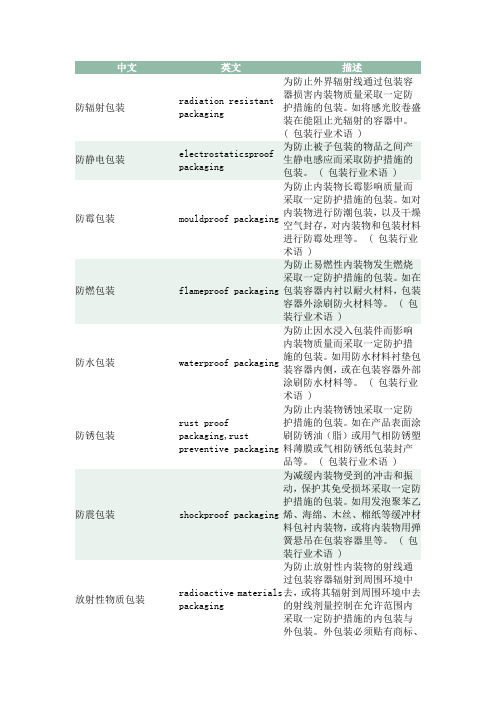
防辐射包装radiation resistantpackaging为防止外界辐射线通过包装容器损害内装物质量采取一定防护措施的包装。
如将感光胶卷盛装在能阻止光辐射的容器中。
( 包装行业术语 )防静电包装electrostaticsproofpackaging为防止被子包装的物品之间产生静电感应而采取防护措施的包装。
( 包装行业术语 ) 防霉包装mouldproof packaging为防止内装物长霉影响质量而采取一定防护措施的包装。
如对内装物进行防潮包装,以及干燥空气封存,对内装物和包装材料进行防霉处理等。
( 包装行业术语 )防燃包装flameproof packaging 为防止易燃性内装物发生燃烧采取一定防护措施的包装。
如在包装容器内衬以耐火材料,包装容器外涂刷防火材料等。
( 包装行业术语 )防水包装waterproof packaging为防止因水浸入包装件而影响内装物质量而采取一定防护措施的包装。
如用防水材料衬垫包装容器内侧,或在包装容器外部涂刷防水材料等。
( 包装行业术语 )防锈包装rust proof packaging,rust preventive packaging 为防止内装物锈蚀采取一定防护措施的包装。
如在产品表面涂刷防锈油(脂)或用气相防锈塑料薄膜或气相防锈纸包装封产品等。
( 包装行业术语 ) 防震包装shockproof packaging 为减缓内装物受到的冲击和振动,保护其免受损坏采取一定防护措施的包装。
如用发泡聚苯乙烯、海绵、木丝、棉纸等缓冲材料包衬内装物,或将内装物用弹簧悬吊在包装容器里等。
( 包装行业术语 )放射性物质包装radioactive materials packaging 为防止放射性内装物的射线通过包装容器辐射到周围环境中去,或将其辐射到周围环境中去的射线剂量控制在允许范围内采取一定防护措施的内包装与外包装。
外包装必须贴有商标、标签,说明放射性物品。
包装行业英语
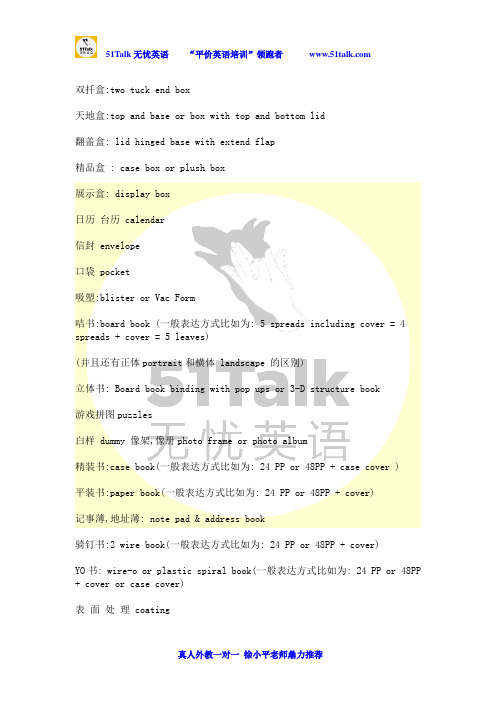
双扦盒:two tuck end box天地盒:top and base or box with top and bottom lid翻盖盒: lid hinged base with extend flap精品盒 : case box or plush box展示盒: display box日历台历 calendar信封 envelope口袋 pocket吸塑:blister or Vac Form咭书:board book (一般表达方式比如为: 5 spreads including cover = 4 spreads + cover = 5 leaves)(并且还有正体portrait和横体 landscape 的区别)立体书: Board book binding with pop ups or 3-D structure book游戏拼图puzzles白样 dummy 像架,像册photo frame or photo album精装书:case book(一般表达方式比如为: 24 PP or 48PP + case cover )平装书:paper book(一般表达方式比如为: 24 PP or 48PP + cover)记事薄,地址薄: note pad & address book骑钉书:2 wire book(一般表达方式比如为: 24 PP or 48PP + cover)YO书: wire-o or plastic spiral book(一般表达方式比如为: 24 PP or 48PP + cover or case cover)表面处理 coating装订 binding光胶 gloss lamination植毛 flocking边着色 painted edge哑胶 matte lamination烫金 foil stamping精装 case making & case in binding 水油 AQU varnish压纹 line embossed平装 perfect bounded印油 press varnish击凸 embossing锁线装 section sewnUV UV varnish夜光油 glowing dark骑马钉装 saddle stitch吸塑油 blister varnish隐形油 invisible UV车线装 singer sewn局部 UV spot UV丝印silk screen咭书装card board lamination金粉glittering珍珠油bronzing varnish YO or蛇仔wire-o & plastic spirals环保吸塑ENV heat-seal环保磨光ENV calendering折页paper folding排咭collate特别UV special UV coating哑油matte varnish裁切trimed or cutting打孔punch hole 上YO closed in单粉咭: C1S art paper (170gsm) or C1S art board (190gsm -450gsm)胶贴纸: Sticker (85gsm) including removable sticker and permanent sticker 硫油纸: Tracing paper瓦楞纸: Flute or corrugate双灰板: Grey board (350gsm -3500gsm) or Chipboard特种纸: Fancy paper铜版纸: Gloss art paper (80gsm -157gsm)原色牛皮: M/F bleached kraft paper白色牛皮:M/G kraft paper布纹纸: Arlin玻璃咭:Kraft liner board拷贝纸:Tissue paper白腊纸: Max paper再造纸:Recycle board新闻纸: News paper (45-55gsm) or newsprint paper书写纸: Wood free paper (60gsm -120gsm) wood free board(>120gsm) 粉灰咭: CCNB board (230gsm -500gsm)无粉咭: Uncoat board(190gsm - 450gsm)双粉咭: C2S art paper(80 -157gsm) or C2S art board (190gsm -450gsm) Die-cuts 啤切Wrong pattern 式样错Trim 切齐/整齐Paint smear 油污Glue joint 胶水贴合/胶水接合点Wrong style 字体错/设计错/类型错Spots /ink picks 污点/脏点Box open joint 爆盒/盒子粘合处分开Streaks 条痕/线条Missing label 标签短少Scratches 擦伤/擦痕Missing print 漏印Upc non-function UPC不良Crease 折痕/弄皱Shadowing 有阴影Indentations 缺口/压痕No glue 无胶水Cracked folds 折叠破裂Glue mark 胶水痕迹Tears 撕破/裂开Poor coating 上光不良Wrong stock NO. 错货号Ink color 墨色Ink density 油墨浓度Glue end flap open 盒开口Seam broken 爆线Water mark 水渍Window detached 爆窗Color mixing 混色Window scratch 胶片擦花Color mismatched 色偏Over softness 太软Dirty 污糟Black white dots 污点(黑白点)Wrong size 尺寸错Cracked damaged 破裂(招致损害) Different color 色偏(颜色不同) Flow mark 水渍痕Poor packing 包装不良Material contaminan 混料(原料污染) Abrasion test fail 磨损测试不合格Glue smear 胶水渍Color run 甩色Poor cutting 裁切不良Wrinkle 皱纹Wrong die cutting 啤切不良Poor forming 折盒不良(外形不同) Scratch 擦痕Wrong grainy cut 裁错纹Glass test fail 光度测试不合格Doubble print 重印(补印)Misc/PVC chips 杂物/胶片破Poor printing 印刷不良Defect sample 样品有缺陷Wrong strippingLinting 纸毛(linty)Color shift 色偏(颜色改变)Misprint 印错,印刷错误Wrong job instruction 开错单Wrong paper material 纸料错Hickl/spot 墨皮/脏点Poor coating 表面处理不良Poor heat-seal 吸塑不良P.P/PVC laminating P.P/PVC不良Broke store line 啤爆线Wrong die-cut 啤切错Wrong creasing 折痕错Poor gluing consistence of sheet laminating /Box 甩坑/粘盒不良Poor window patching/material 胶窗/胶片不良Sratch in printing/coating/window 印刷/上光/胶片粘花Insufficient water 水干Excess water 水大Makeready paper 校版纸Smear 蹭脏Snatching 纸张撕裂Splitting 纸张起毛Slur/sluring 重影/模糊Smash 胶布破裂Soil 污点/弄脏/污斑Soild plate 实地版Soild 实地Soild print 实地印张Sonobook 有声读物Souring 水墨相渗成色不良Softback 平装书软面装订Special binding 精装书,特装书Specimen 样品,样本Specimen book 样书,样本Specimen copy 样本Specimen page 样张Specimen print 试印样Speckle 斑点,小白点Spoils 废品,次品Spot check 抽查Start 装订脱页Super impose 叠印。
包装专业英语
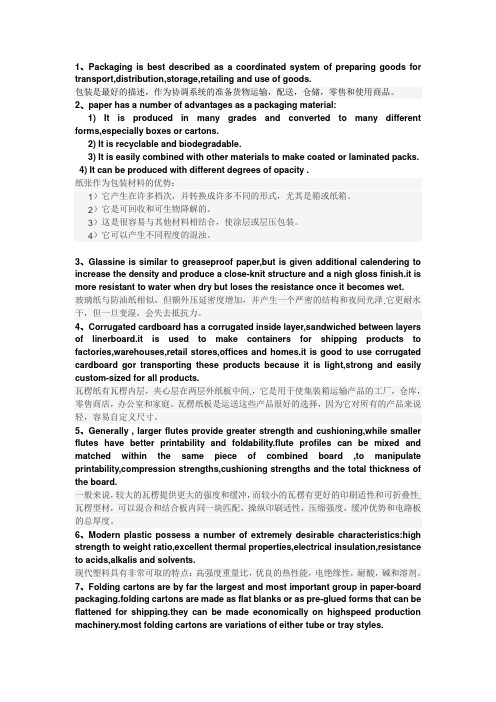
1、Packaging is best described as a coordinated system of preparing goods for transport,distribution,storage,retailing and use of goods.包装是最好的描述,作为协调系统的准备货物运输,配送,仓储,零售和使用商品。
2、paper has a number of advantages as a packaging material:1) It is produced in many grades and converted to many different forms,especially boxes or cartons.2) It is recyclable and biodegradable.3) It is easily combined with other materials to make coated or laminated packs.4) It can be produced with different degrees of opacity .纸张作为包装材料的优势:1)它产生在许多档次,并转换成许多不同的形式,尤其是箱或纸箱。
2)它是可回收和可生物降解的。
3)这是很容易与其他材料相结合,使涂层或层压包装。
4)它可以产生不同程度的混浊。
3、Glassine is similar to greaseproof paper,but is given additional calendering to increase the density and produce a close-knit structure and a nigh gloss finish.it is more resistant to water when dry but loses the resistance once it becomes wet.玻璃纸与防油纸相似,但额外压延密度增加,并产生一个严密的结构和夜间光泽.它更耐水干,但一旦变湿,会失去抵抗力。
印刷包装行业常用英语

印刷包装行业常用英语一、常用英语1.纸张:paper克重:GSM尺寸-size (成品尺寸:TPS)常用纸:common stock开版:imposition (拼版:Film imposition or montage,make-up)2.钉装:binding(锁线装,平装,车线装,胶装,YO装,板书装,骑马钉装(Section sewn, Paperbook binding, single sewn, perfect binding, YO binding, board book binding,saddle stitched binding)3.印刷:printing (平版印刷,胶印或柯式印刷,凸版印刷,柔版印刷,丝网印刷,凹版印刷,(sheetfed printing, offset printing, relief printing, flexography, screen printing, intaglio printing.)4.表面处理:finishing5.装订程序:binding process6.配件:component/accessories7.包装:packing8.运输:transportation9.船务:shipping10.报关:custom11.汇率:currency12.利润:markup profit13.订货:indent14.板纸书:board book15.立体书:pop-ups book16.揭卡书:lift and flap book17.推拉书:pull and push book18.盒:box19.卡板-Pallet20.出口包装外箱:Export carton21.采购订单:Purchase Order二、纸张种类paper grain direction―纸纹stock―仓存both (2/s)side art paper―双粉/双铜- C2S art board or Gloss art paper C2S art paper(80 -157gsm) or C2S art board (190gsm -450gsm)matt art paper(M/A)―哑粉纸matt art card(M/A card)―哑粉卡wood free paper(W/F)―双胶/书纸单粉卡:one side art card (C1S art board)C1S art paper (170gsm) or C1S art board (190gsm -450gsm)coated duplex board(with gray back)(G/B)―粉灰卡/灰底白 (简称:CCNB BOARD) duplex board with white back―灰芯白底白grey board ,millboard,Chipboard―纸板,灰板fancy paper―花纹纸或特种纸new sprint―新闻纸(News paper)light weight coated paper(LWC)―轻涂纸/充粉纸cast coated paper/ cast coated card―玻璃纸/卡 (Kraft liner board)ivory card/uncoated paper―白通卡recycle paper―再造纸/再生纸synthetic(Yupo)paper―合成纸NCR paper―药水纸self-adhesive paper/label-不干胶/贴纸 (Sticker sheet)wood free-书面glossy art―粉面mirror-镜面transparent―透明moveable-可移 non-moveable―不可移 (Permanent)yellow back―黄底white back―白底kraft paper/card―牛皮纸/牛皮卡white kraft paper/card―白色牛皮纸/卡原色牛皮: M/F bleached kraft papercorrugated board/E-flute/stiffener―加固板/坑纸/E坑tracing paper―牛油纸/绘图纸acid-free paper―无酸纸acid-free and lignin-free paper―无酸及不变色纸(clear/white)electrostatic vinyl paper―(透明/白色)静电纸glassine paper―白蜡纸/薄玻璃纸synthetic paper(yupo)―合成纸colour wood free―彩色书纸gold/silver/hologram paper(card)―金/银/镭射纸(卡)拷貝紙:Tissue paper/copy paper仿牛皮纸:Vellum paperCUK Paperboard (Coated Unbleached Kraft) 涂布原色牛皮纸板SBS Paperboard (Solid Bleached Sulfate) 白板纸Recycled Paperboards 回收纸板CCLB (Clay Coated Light Back)CCKB (Clay Coated Kraft Back)三、Finishing表面处理:Hot stamping―烫印 (Foil stamping)Graining―压纹 (Embossed line)Embossing―凹凸Silk screening―丝印Spot thickness UV―丝印局部厚UV , Spot UV--普通局部UV Glittering―丝印(金/幻彩)粉Glow in the dark―丝印夜光Fluorescent―丝印荧光PP(Glossy) lamination―光胶(OPP lamination)Matt lamination―哑胶Water-base la mination―水性裱胶Machine varnishing―机过油(光/哑油)Press varnish Water-base varnishing―水油 (AQU varnish)UV varnishing(glossy/matt)―UV(光/哑)油Calender varnishing―磨光 (ENV calendering )Blister varnishing―吸塑油Playing card varnishing―扑克牌油Flocking-植毛Bronzing Varnish-珍珠水油Invisible UV ink-隐形油墨Thermo-powder--凸字粉Buckram--布紋Linenweave--幼布紋四、钉装―binding1.精装―hard cover/hardback/case bound2.平装―soft cover/limp bound3.假精装―flexible binding/flexibound/dutch bind4.胶装―perfect bound/adhesive binding/notch binding5.骑马钉―saddle stitching/2 wire stitching6.双线圈装―wire-O bound7.铁环装―ring binding8.螺旋装―spiral bound9.round back―圆脊10.square back―方脊11.hallow back―通脊12.casing in―上皮壳13.case making―做壳/造壳14.ribbon marker―丝带15.head&tail(H/T)bands―马头布或堵头布16.punch―冲17.punch to sh ape―冲成形18.die cut―啤19.kiss cut―啤半穿20.perforation―针线21.tipping―贴/首(singler)22.step indexing―打索引23.round corner―圆角24.hot melt―热溶(胶)25.hot seal―热压26.endpaper paste on―贴衬27.section sewn(thread sewn/smith sewn)―穿线(锁线)28.side sewn―车侧线29.center s ewn―车中线(Single sewn)30.center sewn in two section―车中线手反两帖31. 3 edges golden gilt―三边扫金(滚金边)minated indexing(index lamination)―透明胶索引33.Painted edge-边着色五、其它1.text―内页/内文2.endpaper―衬纸3.lining(liner)―裱纸4.insert―插页5.wrap―包页6.tab―检索7.gate fold―拉页10.overlap cover(gate fold cover)―翼仔封面(cover extend flap)11.jacket―护封12.folder―档案夹13.envelope―信封14.index―索引15.photo bag―相袋 or 牛百叶(polypropyleve photo sleeve)16.album―相册17.mail card―邮寄卡/贺卡18.poster―海报19.writing pad―写字薄20.memo pad―记事薄21.ji gsaw puzzle―切图/拼图22.easel―支架23.barcode―电脑条码(ISBN)24.配页-Collate25.Round corner—圆角26.Pocket-袋子27.Paper bag with hander-手提袋8.spacer―隔页9.cover―封面六、盒子Card box―卡盒Rigid box―浆糊盒Match box―火柴盒(盒套盒)Lid and base (bottom) box―天地盒Lid hinge base box --翻盖盒Slipcase―书套盒Folding box―折盒 (飞机盒)Truck box―啤牌盒Two tuck end box –双插盒Tray box―地盒(Base box, bottom box)PVC box―PVC胶盒Counter display box(counter pack)/display box―展示盒Corrugated E-flute box―坑盒Box with zip lock-自动扣底盒Box with lock-扣底盒Case box—精装盒Round box--圆筒盒(Tube box)七、Components(Accessories)配件/附件:Ring binder―铁环圈(铁夹)Wiro-O―双线圈plastic/metal Spiral―(胶/铁)线圈也叫蛇仔Lock―锁Rivet―铆钉、窝钉Eyelet/Grommet―鸡眼Velcro―魔术贴(Fasten tape)Fur--皮革(Leather)Feather―毛绒Cloth―布Flock paper―植绒纸(植毛纸)Plastic(meta l)hanger―胶/铁挂钩Screws―螺丝Satin ribbon―丝带String―绳Elastic(rubber)band(round/flat)―橡皮筋/橡皮根Magnet―磁铁/磁石Plastic band―胶带Flexible magnetic rubber(Plastic magnet)―磁胶(Rubber magnetic sheet ) Metal plate―铁片Ferrous rubber—铁粉片blister―吸塑罩 (Vac form)Polybag(self-adhesive/zip lock)―胶袋(自粘/密实)Double side adhesive tape―双面胶Hologram(hologram foil)―镭射(Laser)Sand paper―砂纸Scented paper―香味纸Styrofoam―泡沫Sponge―海绵( Foam)Stiffener―加固板Hanger wire―挂钩Plastic calendar slide―月历胶夹Lenticular(3D card)―立体卡Hander—提手Plastic snap button –阴阳扣Tipped on flap—书口边的粘条Plastic handle--膠手挽Plastic lock--膠夾Vinyl sticker--靜電貼紙Metal lock--鐵鎖Wafer seal--透明圓貼紙Plush toys--公仔Playing cards--撲克牌Vinyl -膠公仔Ink Pad-印台Plastic tag-- 膠針Rubber stamp--膠印Flashlight--電筒Battery--電池Module--電子發聲器Candy buttons--糖粒Piano module--鋼琴發聲器Plastic clock hands--時鐘膠針Pen--鋼筆/水筆Pencil sharpener--鉛筆刨Holographic sticker--雷射貼紙Highlighter--螢光筆Badge--徽章Eraser--擦字膠PVC / Acetate--透明膠片Crayon--蜡筆Printed Acetate--印好膠片Cable wire--鐵線Hang tag--膠勾Rubber band--橡筋八、包装40” container―468*89*88”(H)(11887*2260*2235mm)20” container―228*89*88”(H) (5791*2260*2235mm)Pallet―卡板(US pallet:40*48*6”,Euro pallet 31.5*47.25*6”)Wood pallet--木制卡板Plastic pallet--胶制卡板Bubble sheet--泡泡紙Corrugated buffer--坑紙隔Retail packing--產品包裝Wholesale packing--批發包裝Mailing carton--郵寄包裝Assortment packing--組合包裝Shipper/Export pack--外箱包裝Palletizing--打卡板Main Mark --正唛Side Mark--侧唛Shipping Mark-- 箱唛Gloss weight—净重FOB--Free On Board (離岸價)Ex-work—出厂价CNF(port) Cost for Ocean freightCIF (port) Cost for Insurance and oceanfreightFIS (warehouse) Cost for ocean freight , insurance and inland trucking DDU DDP。
印刷包装行业常用英语

印刷包装行业常用英语一、常用英语1.纸张:paper克重:GSM尺寸-size (成品尺寸:TPS)常用纸:common stock开版:imposition (拼版:Film imposition or montage,make-up)2.钉装:binding(锁线装,平装,车线装,胶装,YO装,板书装,骑马钉装(Section sewn, Paperbook binding, single sewn, perfect binding, YO binding, board book binding,saddle stitched binding)3.印刷:printing (平版印刷,胶印或柯式印刷,凸版印刷,柔版印刷,丝网印刷,凹版印刷,(sheetfed printing, offset printing, relief printing, flexography, screen printing, intaglio printing.)4.表面处理:finishing5.装订程序:binding process6.配件:component/accessories7.包装:packing8.运输:transportation9.船务:shipping10.报关:custom11.汇率:currency12.利润:markup profit13.订货:indent14.板纸书:board book15.立体书:pop-ups book16.揭卡书:lift and flap book17.推拉书:pull and push book18.盒:box19.卡板-Pallet20.出口包装外箱:Export carton21.采购订单:Purchase Order二、纸张种类paper grain direction―纸纹stock―仓存both (2/s)side art paper―双粉/双铜- C2S art board or Gloss art paperC2S art paper(80 -157gsm) or C2S art board (190gsm -450gsm)matt art paper(M/A)―哑粉纸matt art card(M/A card)―哑粉卡wood free paper(W/F)―双胶/书纸单粉卡:one side art card (C1S art board)C1S art paper (170gsm) or C1S art board (190gsm -450gsm)coated duplex board(with gray back)(G/B)―粉灰卡/灰底白 (简称:CCNB BOARD) duplex board with white back―灰芯白底白grey board ,millboard,Chipboard―纸板,灰板fancy paper―花纹纸或特种纸new sprint―新闻纸(News paper)light weight coated paper(LWC)―轻涂纸/充粉纸cast coated paper/ cast coated card―玻璃纸/卡 (Kraft liner board)ivory card/uncoated paper―白通卡recycle paper―再造纸/再生纸synthetic(Yupo)paper―合成纸NCR paper―药水纸self-adhesive paper/label-不干胶/贴纸 (Sticker sheet)wood free-书面glossy art―粉面mirror-镜面transparent―透明moveable-可移 non-moveable―不可移 (Permanent)yellow back―黄底white back―白底kraft paper/card―牛皮纸/牛皮卡white kraft paper/card―白色牛皮纸/卡原色牛皮: M/F bleached kraft papercorrugated board/E-flute/stiffener―加固板/坑纸/E坑tracing paper―牛油纸/绘图纸acid-free paper―无酸纸acid-free and lignin-free paper―无酸及不变色纸(clear/white)electrostatic vinyl paper―(透明/白色)静电纸glassine paper―白蜡纸/薄玻璃纸synthetic paper(yupo)―合成纸colour wood free―彩色书纸gold/silver/hologram paper(card)―金/银/镭射纸(卡)拷貝紙:Tissue paper/copy paper仿牛皮纸:Vellum paperCUK Paperboard (Coated Unbleached Kraft) 涂布原色牛皮纸板SBS Paperboard (Solid Bleached Sulfate) 白板纸Recycled Paperboards 回收纸板CCLB (Clay Coated Light Back)CCKB (Clay Coated Kraft Back)三、Finishing表面处理:Hot stamping―烫印 (Foil stamping)Graining―压纹 (Embossed line)Embossing―凹凸Silk screening―丝印Spot thickness UV―丝印局部厚UV , Spot UV--普通局部UV Glittering―丝印(金/幻彩)粉Glow in the dark―丝印夜光Fluorescent―丝印荧光PP(Glossy) lamination―光胶(OPP lamination)Matt lamination―哑胶Water-base la mination―水性裱胶Machine varnishing―机过油(光/哑油)Press varnish Water-base varnishing―水油 (AQU varnish)UV varnishing(glossy/matt)―UV(光/哑)油Calender varnishing―磨光 (ENV calendering )Blister varnishing―吸塑油Playing card varnishing―扑克牌油Flocking-植毛Bronzing Varnish-珍珠水油Invisible UV ink-隐形油墨Thermo-powder--凸字粉Buckram--布紋Linenweave--幼布紋四、钉装―binding1.精装―hard cover/hardback/case bound2.平装―soft cover/limp bound3.假精装―flexible binding/flexibound/dutch bind4.胶装―perfect bound/adhesive binding/notch binding5.骑马钉―saddle stitching/2 wire stitching6.双线圈装―wire-O bound7.铁环装―ring binding8.螺旋装―spiral bound9.round back―圆脊10.square back―方脊11.hallow back―通脊12.casing in―上皮壳13.case making―做壳/造壳14.ribbon marker―丝带15.head&tail(H/T)bands―马头布或堵头布16.punch―冲17.punch to sh ape―冲成形18.die cut―啤19.kiss cut―啤半穿20.perforation―针线21.tipping―贴/首(singler)22.step indexing―打索引23.round corner―圆角24.hot melt―热溶(胶)25.hot seal―热压26.endpaper paste on―贴衬27.section sewn(thread sewn/smith sewn)―穿线(锁线)28.side sewn―车侧线29.center s ewn―车中线(Single sewn)30.center sewn in two section―车中线手反两帖31. 3 edges golden gilt―三边扫金(滚金边)minated indexing(index lamination)―透明胶索引33.Painted edge-边着色五、其它1.text―内页/内文2.endpaper―衬纸3.lining(liner)―裱纸4.insert―插页5.wrap―包页6.tab―检索7.gate fold―拉页10.overlap cover(gate fold cover)―翼仔封面(cover extend flap)11.jacket―护封12.folder―档案夹13.envelope―信封14.index―索引15.photo bag―相袋 or 牛百叶(polypropyleve photo sleeve)16.album―相册17.mail card―邮寄卡/贺卡18.poster―海报19.writing pad―写字薄20.memo pad―记事薄21.jigsaw puzzle―切图/拼图22.easel―支架23.barcode―电脑条码(ISBN)24.配页-Collate25.Round corner—圆角26.Pocket-袋子27.Paper bag with hander-手提袋8.spacer―隔页9.cover―封面六、盒子Card box―卡盒Rigid box―浆糊盒Match box―火柴盒(盒套盒)Lid and base (bottom) box―天地盒Lid hinge base box --翻盖盒Slipcase―书套盒Folding box―折盒 (飞机盒)Truck box―啤牌盒Two tuck end box –双插盒Tray box―地盒(Base box, bottom box)PVC box―PVC胶盒Counter display box(counter pack)/display box―展示盒Corrugated E-flute box―坑盒Box with zip lock-自动扣底盒Box with lock-扣底盒Case box—精装盒Round box--圆筒盒(Tube box)七、Components(Accessories)配件/附件:Ring binder―铁环圈(铁夹)Wiro-O―双线圈plastic/metal Spiral―(胶/铁)线圈也叫蛇仔Lock―锁Rivet―铆钉、窝钉Eyelet/Grommet―鸡眼Velcro―魔术贴(Fasten tape)Fur--皮革(Leather)Feather―毛绒Cloth―布Flock paper―植绒纸(植毛纸)Plastic(metal)hanger―胶/铁挂钩Screws―螺丝Satin ribbon―丝带String―绳Elastic(rubber)band(round/flat)―橡皮筋/橡皮根Magnet―磁铁/磁石Plastic band―胶带Flexible magnet ic rubber(Plastic magnet)―磁胶(Rubber magnetic sheet ) Metal plate―铁片Ferrous rubber—铁粉片blister―吸塑罩 (Vac form)Polybag(self-adhesive/zip lock)―胶袋(自粘/密实)Double side adhesive tape―双面胶Hologram(hologram foil)―镭射(Laser)Sand paper―砂纸Scented paper―香味纸Styro foam―泡沫Sponge―海绵( Foam)Stiffener―加固板Hanger wire―挂钩Plastic calendar slide―月历胶夹Lenticular(3D card)―立体卡Hander—提手Plastic snap button –阴阳扣Tipped on flap—书口边的粘条Plastic handle--膠手挽Plastic lock--膠夾Vinyl sticker--靜電貼紙Metal lock--鐵鎖Wafer seal--透明圓貼紙Plush toys--公仔Playing cards--撲克牌Vinyl -膠公仔Ink Pad-印台Plastic tag-- 膠針Rubber stamp--膠印Flashlight--電筒Battery--電池Module--電子發聲器Candy buttons--糖粒Piano module--鋼琴發聲器Plastic clock hands--時鐘膠針Pen--鋼筆/水筆Pencil sharpener--鉛筆刨Holographic sticker--雷射貼紙Highlighter--螢光筆Badge--徽章Eraser--擦字膠PVC / Acetate--透明膠片Crayon--蜡筆Printed Acetate--印好膠片Cable wire--鐵線Hang tag--膠勾Rubber band--橡筋八、包装40” container―468*89*88”(H)(11887*2260*2235mm)20” container―228*89*88”(H) (5791*2260*2235mm)Pallet―卡板(US pallet:40*48*6”,Euro pallet 31.5*47.25*6”)Wood pallet--木制卡板Plastic pallet--胶制卡板Bubble sheet--泡泡紙Corrugated buffer--坑紙隔Retail packing--產品包裝Wholesale packing--批發包裝Mailing carton--郵寄包裝Assortment packing--組合包裝Shipper/Export pack--外箱包裝Palletizing--打卡板Main Mark --正唛Side Mark--侧唛Shipping Mark-- 箱唛Gloss weight—净重FOB--Free On Board (離岸價)Ex-work—出厂价CNF(port) Cost for Ocean freightCIF (port) Cost for Insurance and oceanfreightFIS (warehouse) Cost for ocean freight , insurance and inland trucking DDU DDP。
印刷包装行业常用英语

1.纸张:paper克重:GSM开版:imposition2.钉装:binding(锁线装,平装,车线装,胶装,YO 装,板书装,骑马钉装(Section sewn, Paperbook binding, single sewn, perfect binding, YO binding, board book binding,saddle stitched binding)3.印刷:printing (平版印刷,胶印或柯式印刷,凸版印刷,柔版印刷,丝网印刷,凹版印刷,(sheetfed printing, offset printing, relief printing, flexography, screen printing, intaglio printing.)4.表面处理:finishing5.装订程序:binding process6.配件:component/accessories7.包装:packing8.运输:transportation9.船务:shipping10.报关:custom11.汇率:currency/rate12.利润:markup profit13.订货:indent/order/purchase/book14.板纸书:board book15.立体书:pop-ups book16.揭卡书:lift and flap book17.推拉书:pull and push book18.盒:box19.卡板-Pallet20.出口包装外箱:Export carton21.采购订单:Purchase Order常用纸:common stock尺寸-size (成品尺寸:TPS)拼版:Film imposition or montage,make-up二、纸张种类both (2/s)side art paper―双粉/双铜- C2S art board or Gloss art paper C2S art paper(80 -157gsm) or C2S art board (190gsm -450gsm)matt art paper(M/A)―哑粉纸 matt art card(M/A card)―哑粉卡wood free paper(W/F)―双胶/书纸单粉卡:one side art card (C1S art board)C1S art paper (170gsm) or C1S art board(190gsm -450gsm)grey board ,millboard,Chipboard―纸板,灰板fancy paper―花纹纸或特种纸cast coated paper/ cast coated card―玻璃纸/卡 (Kraft liner board) ivory card/uncoated paper―白通卡recycle paper―再造纸/再生纸synthetic(Yupo)paper―合成纸NCR paper―药水纸self-adhesive paper/label-不干胶/贴纸 (Sticker sheet) mirror-镜面 transparent―透明moveable-可移 non-moveable―不可移 (Permanent) yellow back―黄底 white back―白底kraft paper/card―牛皮纸/牛皮卡white kraft paper/card―白色牛皮纸/卡原色牛皮: M/F bleached kraft paperwood free-书面 glossy art―粉面coated duplex board(with gray back)(G/B)―粉灰卡/灰底白 (简称:CCNB BOARD) duplex board with white back―灰芯白底白gold/silver/hologram paper(card)―金/银/镭射纸(卡)拷貝紙:Tissue paper/copy paperpaper grain direction―纸纹 stock―仓存colour wood free―彩色书纸clear/white)electrostatic vinyl paper―透明/白色)静电纸newsprint―新闻纸(News paper)light weight coated paper(LWC)―轻涂纸/充粉纸CUK Paperboard (Coated Unbleached Kraft) 涂布原色牛皮纸板 SBS Paperboard (Solid Bleached Sulfate) corrugated board/E-flute/stiffener―加固板/坑纸/E坑tracing paper―牛油纸/绘图纸acid-free paper―无酸纸acid-free and lignin-free paper―无酸及不变色纸glassine paper―白蜡纸/薄玻璃纸synthetic paper(yupo)―合成纸仿牛皮纸:Vellum paperRecycled Paperboards 回收纸板CCLB (Clay Coated Light Back)CCKB (Clay Coated Kraft Back)三、Finishing表面处理:Hot stamping―烫印 (Foil stamping)Graining―压纹 (Embossed line)Embossing―凹凸Silk screening―丝印Spot thickness UV―丝印局部厚UV , Spot UV--普通局部UV Glittering―丝印(金/幻彩)粉Glow in the dark―丝印夜光Fluorescent―丝印荧光PP(Glossy) lamination―光胶(OPP lamination)Matt lamination―哑胶Water-base lamination―水性裱胶Flocking-植毛UV varnishing(glossy/matt)―UV(光/哑)油Calender varnishing―磨光 (ENV calendering ) Blister varnishing―吸塑油Playing card varnishing―扑克牌油Machine varnishing―机过油(光/哑油)Press varnish Water-base varnishing―水油 (AQU varnish) Bronzing Varnish-珍珠水油Invisible UV ink-隐形油墨Thermo-powder--凸字粉Buckram--布紋Linenweave--幼布紋四、钉装―binding1.精装―hard cover/hardback/case bound2.平装―soft cover/limp bound3.假精装―flexible binding/flexibound/dutch bind4.胶装―perfect bound/adhesive binding/notch binding5.骑马钉―saddle stitching/2 wire stitching6.双线圈装―wire-O bound7.铁环装―ring binding8.螺旋装―spiral bound9.round back―圆脊10.square back―方脊11.hallow back―通脊12.casing in―上皮壳13.case making―做壳/造壳14.ribbon marker―丝带15.head&tail(H/T)bands―马头布或堵头布16.punch―冲17.punch to shape―冲成形18.die cut―啤19.kiss cut―啤半穿20.perforation―针线21.tipping―贴/首(singler)22.step indexing―打索引23.round corner―圆角24.hot melt―热溶(胶)25.hot seal―热压26.endpaper paste on―贴衬27.section sewn(thread sewn/smith sewn)穿线锁线28.side sewn―车侧线29.center sewn―车中线(Single sewn)30.center sewn in two section―车中线手反两帖31. 3 edges golden gilt―三边扫金(滚金边)minated indexing(index lamination)透明胶索引33.Painted edge-边着色五、其它1.text―内页/内文2.endpaper―衬纸3.lining(liner)―裱纸4.insert―插页5.wrap―包页6.tab―检索7.gate fold―拉页10.overlap cover(gate fold cover)―翼仔封面(cover extend flap)11.jacket―护封12.folder―档案夹13.envelope―信封14.index―索引15.photo bag―相袋 or 牛百叶(polypropyleve photo sleeve)16.album―相册17.mail card―邮寄卡/贺卡18.poster―海报19.writing pad―写字薄20.memo pad―记事薄21.jigsaw puzzle―切图/拼图22.easel―支架23.barcode―电脑条码(ISBN)24.配页-Collate25.Round corner—圆角26.Pocket-袋子27.Paper bag with hander-手提袋28.spacer―隔页29.cover―封面六、盒子Card box―卡盒Rigid box―浆糊盒Match box―火柴盒(盒套盒)Lid and base (bottom) box―天地盒Lid hinge base box --翻盖盒Slipcase―书套盒Folding box―折盒 (飞机盒)Truck box―啤牌盒Two tuck end box –双插盒Tray box―地盒(Base box, bottom box)PVC box―PVC胶盒Counter display box(counter pack)/display box―展示盒 Corrugated E-flute box―坑盒Box with zip lock-自动扣底盒Box with lock-扣底盒Case box—精装盒Round box--圆筒盒(Tube box)七、Components(Accessories)配件/附件:Ring binder―铁环圈(铁夹)Wiro-O―双线圈plastic/metal Spiral―胶/铁)线圈也叫蛇仔 Lock―锁Rivet―铆钉、窝钉Eyelet/Grommet―鸡眼Velcro―魔术贴(Fasten tape)Fur--皮革(Leather)Feather―毛绒Cloth―布Flexible magnetic rubber(Plastic magnet)―磁胶(Rubber magnetic sheet ) Metal plate―铁片blister―吸塑罩 (Vac form)Polybag(self-adhesive/zip lock)胶袋(自粘/密实)Double side adhesive tape―双面胶Hologram(hologram foil)―镭射(Laser)Sand paper―砂纸Hander—提手Plastic snap button –阴阳扣Tipped on flap—书口边的粘条Plastic handle--膠手挽Plastic lock--膠夾Vinyl sticker--靜電貼紙Metal lock--鐵鎖Wafer seal--透明圓貼紙Plush toys--公仔Playing cards--撲克牌Vinyl -膠公仔Ink Pad-印台Plastic tag-- 膠針Rubber stamp--膠印Flashlight--電筒Battery--電池Flock paper―植绒纸(植毛纸)Plastic(metal)hanger―胶/铁挂钩Screws―螺丝Satin ribbon―丝带String―绳Elastic(rubber)band(round/flat)―橡皮筋/橡皮根Magnet―磁铁/磁石Plastic band―胶带Lenticular(3D card)―立体卡Scented paper―香味纸Styrofoam―泡沫Ferrous rubber—铁粉片Sponge―海绵( Foam)Stiffener―加固板Hanger wire―挂钩Plastic calendar slide―月历胶夹Module--電子發聲器Candy buttons--糖粒Piano module--鋼琴發聲器Plastic clock hands--時鐘膠針Pen--鋼筆/水筆Pencil sharpener--鉛筆刨Holographic sticker--雷射貼紙Highlighter--螢光筆Badge--徽章Eraser--擦字膠PVC / Acetate--透明膠片Crayon--蜡筆Printed Acetate--印好膠片Cable wire--鐵線Hang tag--膠勾Rubber band--橡筋八、包装40” container-468*89*88”(H)(11887*2260*2235mm) Pallet―卡板(US pallet:40*48*6”,Euro pallet31.5*47.25*6”) Wood pallet--木制卡板Gloss weight—净重FOB--Free On Board (離岸價)Ex-work—出厂价CNF(port) Cost for Ocean freightCIF (port) Cost for Insurance and oceanfreight Loose Cargo Load --散貸 (簡稱LCL)Full Container Load-柜貸 (簡稱FCL)Terminal Handling Charges 碼頭操作費用Fumigation--消毒ETD :Estimated Time of Departure (預定離港日期) ETA:Estimated Time of Arrival (預計到岸日期)Ex-factory:離廠日期Payment term—支付条件(TT OA LC BL)20” container―228*89*88”(H) (5791*2260*2235mm) FIS (warehouse) Cost for ocean freight , insurance and inland trucking DDU DDP。
印刷包装专业英语

印刷包装专业英语包装专业术语(常用词语中英文对照表)面顶:the top of the box沙顶:inside of top lid内玉:interior/inlay孔位:recess烫金Hot stamping压印Embossing丝印Silkscreen printingLaser engraving 雕刻魔术贴velcro绒布velvet植绒flocking哑光matt finishglossy finish 亮光piano finish 钢琴漆gross weight毛重net weight 净重kraft 牛皮纸蜡纸waxpaperregular packing for export正规出口包装insufficiently packed 包装不固bags torn 袋子撕破plastic transparency box 塑料透明盒苯乙烯盒styrol boxcontainer 集装箱托盘pallet码yard蛋形egg-shapedpentagon 五边形hexagon 六边形heptagon 七边形octagon 八边形long 长wide 宽high 高deep 深thick 厚length 长度width 宽度height 高度depth 深度厚度thicknessbottom 盒子的底部盒子的顶部top (upper) inflammablekeep drykeep away from moisturekeep in the cool palcekeep upright 请勿倒置not to be tipped 请勿倾倒放水布canvas cloth , canvas sheet , 聚乙烯薄膜polyethylene film薄膜film颜料paintwater-repellent paint 防水油漆绳子CORDnumber of a cargo waybill 货运单号码包装用的绳子,运单packing string货运单cargo waybill印刷专业英语(常用词语中英文对照表)2 wire stitching 骑马钉board book binding 板纸书(合板)3 edges golden gilt 三面烫金边book block 毛书Accordion 风琴式折页both(2/s)side art paper 双粉纸acid-free and lignin free paper 无酸及不变色纸both side 双面acid-free paper 无酸纸both side art card 双粉咭(C2S)adhesive binding 胶装/无线胶装both side art paper 双粉纸(C2S) adhesive tape double 双面胶纸bound volume/bound edition 合订书/合订本adhesive tape single 单面胶纸box 盒advance copies 新书样本/船头版Brazil 巴西after-press 印后Brochure/booklet/pamphlet/handbook 小册子air freinght/airlift/air-express/air-ferry 空运brown wrapping/kraft/vellum 牛皮纸Album 相簿building in 压线/压衬Arlin 布纹纸/书皮纸bulk 大货/厚度customer service department 客户服务部flap 旗/翼仔cut flush 切正三边(封面及内文的三边一起切齐) flat 平的cutting 切纸flexible binding 假精装Cyan 青蓝flexible magnetic rubber 胶磁debossing 击凹flock paper 植毛(纸)delivery note 送货单flow chart 流程图Diary/daybook 日记簿fluorescent 荧光墨/发荧光的die cut 啤flyeaf 衬纸/封里纸die-cut mould 啤板Foam/sponge 海绵die-cutter 啤机/模切机FOB 离岸价dividers 烟的士foil stamping 烫色hickey 墨屎folded and gathered 已折和已排但未装订的书(F&G) high bulk paper 高容积纸/特厚纸folder 档案夹high gloss varnish 特光folding 折/折书/折页hinge 书链folding box 折盒Holland 荷兰Folio 页码hologram paper(card) 激光纸(咭)fore edge 书口/前切线hologram stamping 激光烫format 格式horizontal 横度freight 运费hot melt 热溶胶french fold jacket/ slipcase 法式书套hot seal 热压/热封口Fur 皮革hot stamping 热烫/烫色gate fold 拉页H/T band(head and rail bands/headband) 笃(绳)头布(H.T) gatering 排书/配页illustrations 插图gathering 排书/配书image 影像ghosting 鬼影imitation gold 仿金gift box 礼盒imposition 拼版glassine paper 白腊纸Impression 印数/印张/压印Gloss(y) art(paper) 光粉纸(G/A) imprint 版权页Glue/gluewater/gumwater 胶水indent 订货gluing 涂胶index 索引gold blocking 烫金indexing 索引裁切/打烟的士gold paper(card) 金纸(咭) Indonesia 印尼gold stamping 金烫/烫金Indonesian 印尼的Grain direction 丝缕方向/纸纹方向information 讯息grams per square metre 克/平方米(GSM) Insert / inset /foldout 插页gravure Printing 滚筒式印刷/凹版印刷inset 套贴Green 绿色interleaves 内隔页greyboard 双灰international standard book number 国际标准书籍号码(ISBN)grey board 版纸ivory board 通咭gripper 牙口ivory card 白通纸grommet 鸡眼jacket 书套/护封/封套/书衣Gross weight 毛重jacketting 上书套/上护封guillotine 切纸机Japan 日本half title page 半书名页或/部首专页Japanese 日本的half-tone 半色调job number 工程编号hollow back 通脊joint 书脊槽各种纸材料:单铜纸:C1S art paper or C1S art board双灰板:Grey board铜版纸:Coated Art Paper(or Board)/glossy coated paper/SBS(Solid Bleached Sulphate):C1S(coated one side单铜纸)和C2S(coated two sides双铜纸)。
包装盒相关词汇
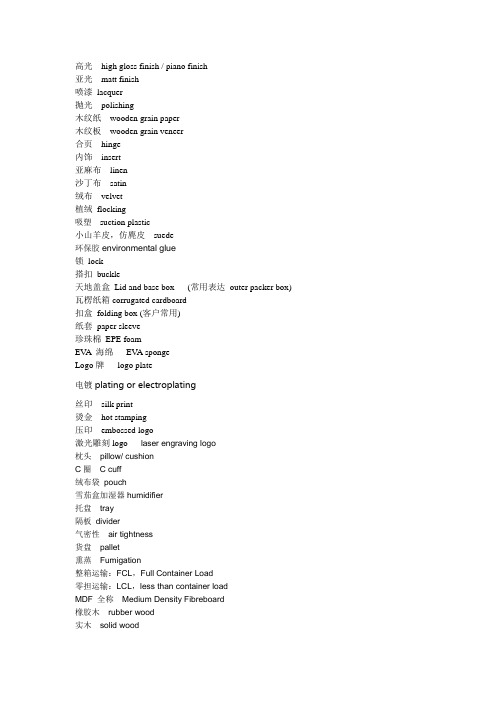
橡胶木rubber wood
实木solid wood
桦木birch
樱桃木cherry wood
橡木oak
桃花芯木mahogany
笔套pen holder
纸套paper sleeve
珍珠棉EPE foam
EVA海绵EVA sponge
Logo牌logo plate
电镀plating or electroplating
丝印silk print
烫金hot stamping
压印embosLeabharlann ed logo激光雕刻logolaser engraving logo
枕头pillow/ cushion
C圈C cuff
绒布袋pouch
雪茄盒加湿器humidifier
托盘tray
隔板divider
气密性air tightness
货盘pallet
熏蒸Fumigation
整箱运输:FCL,Full Container Load
零担运输:LCL,less than container load
highglossfinishpianofinish亚光mattfinish喷漆lacquer抛光polishing木纹纸woodengrainpaper木纹板woodengrainveneer合页hingeinsert亚麻布linensatin绒布velvetsuctionplastic小山羊皮仿麂皮suede环保胶environmentalgluelock搭扣buckle天地盖盒lidbasebox常用表达outerpackerbox瓦楞纸箱corrugatedcardboardfoldingbox客户常用纸套papersleeve珍珠棉epefoameva海绵evaspongelogologoplate电镀platingelectroplating丝印silkprint烫金hotstamping压印embossedlogo激光雕刻logolaserengravinglogo枕头pillowcushioncuff绒布袋pouch雪茄盒加湿器humidifier托盘tray隔板divider气密性airtightnesspallet熏蒸fumigation整箱运输
包装印刷英语

包装印刷词汇1.Adhesive tape double 双面胶纸2.both side art paper 双粉纸(C2S)3.adhesive tape single单面胶纸4.Brown wrapping/kraft/vellum 牛皮纸5.calendering 磨光6.calender varnishing 磨光7.card board咭纸 8.card box 咭盒9.carton 纸箱、坑箱、卡通纸 10.1 ply B8 corrugated board B8单层坑纸11.Binding 装订 12.binding board 灰板、板纸13.Blister 吸塑14.Board 咭纸15.die-cutting模切、啤 16.coated two side 双粉(C2S)17.coated one side 单粉(C1S) 18. coated paper.铜板纸19.embossing die 击凹凸模 20.endpaper paste on 贴衬21.corrugated E-flute box 坑盒 22.exported carton 出口纸箱23.corrugated paper 瓦楞纸、坑纸 24.eyelet/grommet鸡眼25.film 菲林 26.cutting切纸27.flock paper 植毛(纸)28.debossing 击凹29.die cut 啤30.die-cut mould 啤板31.die-cutter 啤机、模切机32.foil stamping 烫色33.hot melt 热熔胶 34.hot seal 热压、热封口35.Fur 皮革 36.hot stamping 热烫、烫色37.foam/sponge海绵38.ghosting 鬼影39.imposition 拼版 40.Impression 印数、印张、压印41.gluing 涂胶 42.gift box 礼盒43.gold blocking 烫金 44.gold stamping 金烫、烫金45.grams per square metre 克/平方米GSM 46.Insert/inset/foldout 插页47.interleaves 内隔页 48.greyboard 双灰49.gripper 牙口50.guillotine 切纸机51.half-tone 单色调52.hollow back 通脊53.hardback 精装 54.hard back 精装书55.heat-seal calendar varnish 磨光吸塑minated indexing(index lamination)透明胶minating 过胶PP、压塑料膜 58.Leaf 张页(2PP)59.leaflet 小折张、单张、折页 60.Metal colour 金属墨61.Lid 盒盖 lboard 版纸63.Lid and base box 天地盒64.mounting 对裱65.Mount(pasted)裱纸 66. lining 裱纸、裱背、皮壳贴被纸67.multi-colour 多色68.lock-bottom 扣底69.Lock 锁 70.nipping 压印线、书贴压紧71.notch bound 通气胶装NB 72.Machine varnishing 机过油(光、哑)73.Matt laminating 哑胶 74.Gloss Laminating光胶75.Offset printing 柯式印刷 76.Magnet 磁石77.one side art card 单粉咭C1S 78.makeready sheet 校版纸79.out of register 套印不准80.matt art paper 哑粉纸M/A81.Packaging 包装 82.punch board 打孔83.PVC box PVC 胶盒 84.PVC widow 透明胶片窗口85.plastic 塑料 86. rigid box 浆糊盒87.plastic magnet 胶磁 88.Plate 印板89.Plate making 制版 90.PMS colour(Pantone)PMS 专色91.round back 圆脊 92.round corner 圆角93.scoring 啤线 94.printed sheet 印张95.scratching 刮花、拖花96.Process 四色墨97. Scumming 弄脏、糊版(印件)98.section sewn 穿线99.self cover 自封 100.shrink wrapped (individual /assort per pack)收缩包装(独立/每包)101.varnishing (glossy/matt)局部UV油(光/哑)102.silk -screen printing 丝网印刷103.step indexing 打索引、打梯级 104.silk screening 丝印105.sticker 胶贴纸、贴纸106.silk screen pvc sheet 丝印PVC胶片107.stiffener 加固板(E-flute) 108.silver paper(card)银纸(咭)109.silver stamping 银烫、烫银 110.string 绳111.substance 克重、基重 112.sketch 草图、简图113.slip case 书套盒、书盒 114.westage 损耗115.water-based varnishing 过水油(过水溶性光油116.waterproof (gloss/matt)防水(光、哑)117.tracing paper 生油纸 118.whiteness 白度119.trimming 裁切 120.triple wall carton 三坑箱121. windowing 粘窗、贴窗 122.UV varnishing 过UV油、紫外光固化油123.Varnishing 上光油 124.zine plate 锌版125.V-shape die-cutting 啤V位126.zip lock bag 密实胶袋127.paperback 平装书128.Hardback 精装书129.Adjunct 辅料、配件、附属物 130.Bead 小珠子、珠子131.Bow or bowknot 蝴蝶结 132.embossing 击凸后工艺烫金gold blocking 击凸embossing过胶PP 哑胶matt lamination 光胶gloss lamination丝印silk screening 光油gloss oil UV原材料灰板纸 grey board 250g-2000g 常用铜版纸 art paper双胶纸two-side offset paper单粉纸one-side art paper 800g-1800g牛皮纸 Kraft单白纸双灰纸grey chip board啤=压痕、模切embossing/ die cutting。
包装盒用英语怎么说
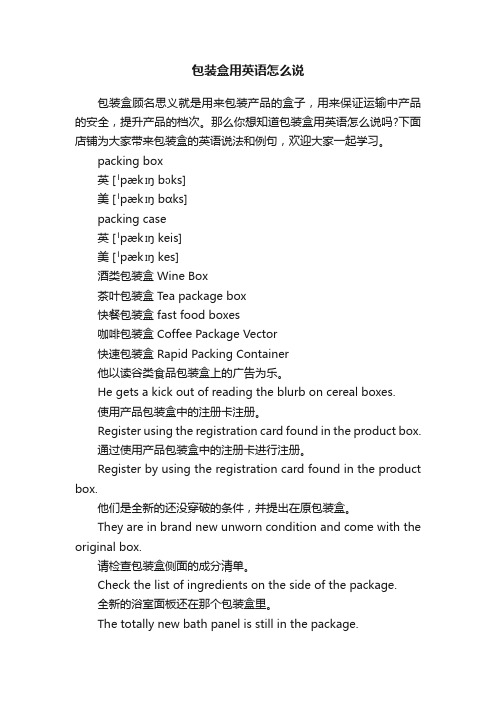
包装盒用英语怎么说包装盒顾名思义就是用来包装产品的盒子,用来保证运输中产品的安全,提升产品的档次。
那么你想知道包装盒用英语怎么说吗?下面店铺为大家带来包装盒的英语说法和例句,欢迎大家一起学习。
packing box英 [ˈpækɪŋ bɔks]美 [ˈpækɪŋ bɑks]packing case英 [ˈpækɪŋ keis]美 [ˈpækɪŋ kes]酒类包装盒 Wine Box茶叶包装盒 Tea package box快餐包装盒 fast food boxes咖啡包装盒 Coffee Package Vector快速包装盒 Rapid Packing Container他以读谷类食品包装盒上的广告为乐。
He gets a kick out of reading the blurb on cereal boxes.使用产品包装盒中的注册卡注册。
Register using the registration card found in the product box.通过使用产品包装盒中的注册卡进行注册。
Register by using the registration card found in the product box.他们是全新的还没穿破的条件,并提出在原包装盒。
They are in brand new unworn condition and come with the original box.请检查包装盒侧面的成分清单。
Check the list of ingredients on the side of the package.全新的浴室面板还在那个包装盒里。
The totally new bath panel is still in the package.制造商将价格标在包装盒上。
The manufacturer marked the price on the packing box.包装盒还是由再循环纸板制成......And the box is made from recycled cardboard.电源线应圈成梳妆连同轧刀放入原包装盒内。
外贸英语常用包装词汇
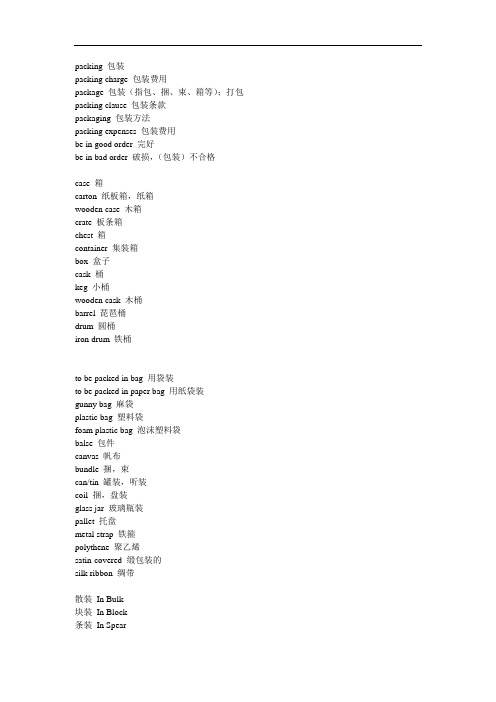
packing 包装packing charge 包装费用package 包装(指包、捆、束、箱等);打包packing clause 包装条款packaging 包装方法packing expenses 包装费用be in good order 完好be in bad order 破损,(包装)不合格case 箱carton 纸板箱,纸箱wooden case 木箱crate 板条箱chest 箱container 集装箱box 盒子cask 桶keg 小桶wooden cask 木桶barrel 琵琶桶drum 圆桶iron drum 铁桶to be packed in bag 用袋装to be packed in paper bag 用纸袋装gunny bag 麻袋plastic bag 塑料袋foam plastic bag 泡沫塑料袋balse 包件canvas 帆布bundle 捆,束can/tin 罐装,听装coil 捆,盘装glass jar 玻璃瓶装pallet 托盘metal strap 铁箍polythene 聚乙烯satin-covered 缎包装的silk ribbon 绸带散装In Bulk块装In Block条装In Spear片装In Slice捆(扎)装In Bundle裸装In Nude裸散装Bare in Loosebreakage-proof 防破损shake-proof 防震leakage-proof 防漏water-proof 防水sound-proof 隔音parcel 小包,一批货packed cargo 包装货parcel post 包裹邮寄single packing 单件包装collective packing 组合包装outer packing 大包装,外包装inner packing 内包装,小包装传统包装Traditional Packing 中性包装Neutral Packing水密Water Tight气密Air Tight不透水包Water Proof Packing 不透气包Air Proof Packing薄膜Film Membrane透明纸Transparent Paper牛皮纸Kraft Paper腊纸Waxpaper厚板纸Cardboard Paper蒲、苇Bulrush mat防水纸Water Proof Paper保丽龙(泡沫塑料)Poly Foam(SnowBox)竹条Bamboo Batten竹篾Bamboo Skin狭木条Batten铜丝Brass Wire铁丝Iron Wire铁条Iron Rod扣箍Buckle用牢固的纸箱装运Packed in Strong Carton适合于长途海洋运输Suitable for Long Distance Ocean Transportation 适合出口海运包装Packed in Seaworthy Carton for Export纸屑Paper Scrap纸条Paper Slip纸带Paper Tape纸层Paper Wool泡沫塑料Foamed Plastics泡沫橡胶Foamed Rubber帆布袋内充水Canvas Bag Filled with Water包内衬薄纸Lined with Thin Paper内衬锡箔袋Lined with Frescobag内置充气氧塑料袋Inner Poly Bag Filled with Oxygen内衬牛皮纸Lined with Kraft Paper内衬防潮纸Lined with Moist Proof Paper铝箔包装In Aluminium Foil Packing木箱内衬铝箔纸Lined with Aluminium Foil in the Wooden Casemark 唛头Indicative Mark 指示性标志Warning Mark 警告性标志upward 向上,由下往上This Side Up 此端向上Handle With Care 小心轻放Keep Upright 勿倒置Use No Hooks 请勿倒挂Not to be tripped 勿倾倒Keep in a dry place 在干燥处保管Keep in a cool place 在冷处保管Keep away from boilers 远离锅炉Keep away from heat 请勿受热Keep away from cold 请勿受冷Keep Dry 防湿rough handling 粗率的处理(搬运,装运货物)to reinforce the packing 加固包装Explosive 爆炸品Fragile 易碎品Inflammable 易燃品Inflammable Gas 易燃气体Inflammable Solid 易燃固体Inflammable Liquid 易燃液体Dangerous When Wet 遇水燃烧品Poison 毒剂Poison Gas 毒气Spontaneously Combustible 自燃物Oxidizing Agent 氧化剂Radioactive 放射性物品Corrosive 腐蚀性物品。
食品专业英语之食品包装
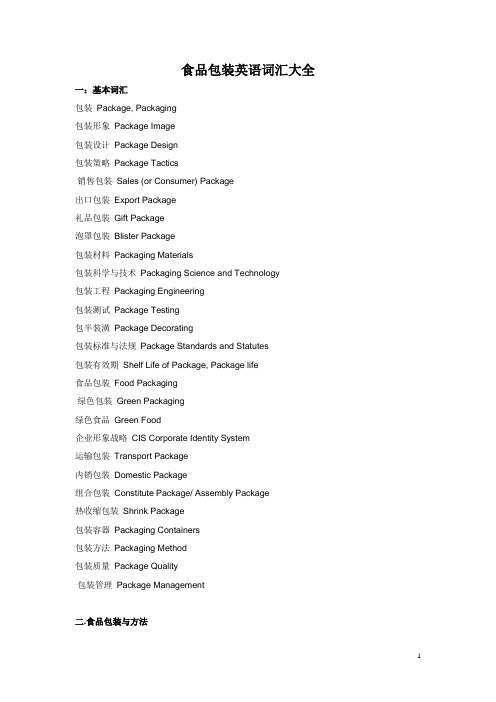
食品包装英语词汇大全一:基本词汇包装Package, Packaging包装形象Package Image包装设计Package Design包装策略Package Tactics销售包装Sales (or Consumer) Package出口包装Export Package礼品包装Gift Package泡罩包装Blister Package包装材料Packaging Materials包装科学与技术Packaging Science and Technology包装工程Packaging Engineering包装测试Package Testing包半装潢Package Decorating包装标准与法规Package Standards and Statutes包装有效期Shelf Life of Package, Package life食品包装Food Packaging绿色包装Green Packaging绿色食品Green Food企业形象战略CIS Corporate Identity System运输包装Transport Package内销包装Domestic Package组合包装Constitute Package/ Assembly Package热收缩包装Shrink Package包装容器Packaging Containers包装方法Packaging Method包装质量Package Quality包装管理Package Management二.食品包装与方法食品品质Food Quality食品氧化Food Oxidation食品微生物Food Microorganism食品营养Food Nutrition高温杀菌High Temperature Sterilization蒸煮袋Retortable Pouch冻结Freezing化学防腐Chemical Preservation辐照防腐Radiation Asepsis食品添加剂Food Additive微波灭菌Microwave Sterilization食品脱水Food Dehydration食品腌渍防腐Food Preservation食品褐变变色Food Browning非酶褐变Non-Enzymatic browning渗透性Permeability饱和吸湿量Saturated Moisture Content环境因素Environmental Factor食品冷藏Refrigerated Storage of Food水分活度Water Activity冷冻调理食品Frozen Prepared Food低温贮藏Low-temperature Storage冷藏Refrigerated Storage冰温贮藏Ice-temperature Storage化学防腐剂Chemical Preservative辐射剂量Radioactive Dosage (or Dosage of Radiation)杀菌剂Fungicide微波辐射Microwave Radiation食品包装food packaging (food packing ,food package )真空包装vacuum packing充气包装gas flush packaging (gas packing )无菌包装aseptic packaging (aseptic packing )食品浓缩Food Concentration食品烟熏防腐Fumigation Asepsis of Food酶促褐变Enzymatic Browning油脂氧化Oxidation of Fat and Oils食品吸湿Moisture absorbability of food临界水分值Critical Moisture Content三.食品包装材料纸与纸板paper and Board牛皮纸Kraft Paper鸡皮纸W. G. Wrapping Paper玻璃纸Glass Paper (Cellophane)糖果包装纸Kiss Paper涂布纸White Board白纸板White board再生纸板Reclaimed board牛皮箱纸板kraft Liner board瓦楞纸板Corrugated Board瓦楞纸箱Corrugated Box折叠盒Folding Cartons衬袋盒(箱) Bag-in -box复合纸罐Composite Paper-Can纸质托盘Paper-Tray定量net weight羊皮纸Parchment Paper半透明纸Semitransparent Paper普通食品包装纸Food Packaging Paper茶叶袋滤纸Tea Bag Paper复合纸Composite Paper黄纸板Straw Board箱纸板Case Board瓦楞原纸Corrugating Base Paper包装纸箱Packaging Box纸盒Paper Box固定盒Set-up Box纸浆模制品Pulp Mould复合纸杯Composite Paper -Cup纸袋Paper Bag塑料包装材料Plastic Packaging Materials热塑性塑料Thermo Plastic塑料树脂Plastic Resin聚乙烯Polyethylene高密度聚乙烯High Density Polyethylene聚丙烯Polypropylene聚氯乙烯Polyvinyl Chloride聚酯Polyethylene Terephthlate聚酰胺Polyamide乙烯-乙烯醇共聚物Ethylene-Vinyl Alcohol Copoyhner 离子型聚合物Ionomer聚氨脂Polyurethane环境可降解塑料Environmental lysis film塑料薄膜Plastic Film热收缩薄膜Shrink Film复合薄膜Compsite Fism蒸煮袋Retortable Pouch生物降薄膜Biolysis Film塑料瓶Plastic Bottle热固性塑料Thermoset Plastic低密度聚乙烯Low Density Polyethylene线型低密度聚乙烯Linear Low density Polyethylene 聚苯乙烯Polystyrene聚偏二氯乙烯Poly vinylidene Chlorie (saran)聚碳酸酯Polycarbonate聚乙烯醇Polyvinyl Alcshol乙烯-醋酸乙烯共聚物Ethylene Vinylacetate聚四氟乙烯(PTFE) Polyterafluoroethylene定向拉伸薄膜Stretched Film弹性薄膜Elastic Film塑料薄膜袋Plastic film Bag可食薄膜Edible Film光降解膜Light ?lysis Film塑料桶Plastic Drum塑料保温箱Plastic Foam Box热成型容器thermo Form Containers助剂(添加剂) Additives增塑剂Plasticizers稳定剂Stabilizers填充剂Fillers着色剂Colorants金属包装材料和容器Metal Packaging Material and Containers 镀锡薄钢板Tinplate镀锌薄钢板Enplate铝合金薄板Aluminium Alloy Plate铝箔Aluminium Foil金属罐Metal Can两片罐Two-piece Can圆罐Round Can方罐Rectagular Can梯形罐trapezoidal Can浅冲罐Drawn Can钙塑瓦楞箱Calp Box塑料片材Plastic sheet毒性Toxicity安全性Safety透气性Gas Permeability透湿性Water Vapor Permeability渗透性Permeability镀铬薄钢板Tin-free ?Steel-or TFS低碳薄钢板Low Carbon Steel真空镀铝膜Al metallizing Fool三片罐Three ?piece Can组合罐Composite Can异形罐Irregular Can椭圆罐Oval Can缩颈罐Necked-in Can深冲罐deep Drawn Can变薄拉伸罐Crawn and Ironed Can焊缝罐Resistance Welding Can易开罐Easy Open Can铝质罐aluminum Can涂料罐Lacquered Tin Plate Can罐盖End (or Lid or Cover)全开盖Full Open Can金属软管Metal Collapsible Tube玻璃容器Glass Containers瓶罐Container轻量瓶Light weight Container软饮料瓶Soft drink bottle陶瓷电装容器Pottery and Porcelain Packaging Containers 包装辅助材料ancillary Packaging Materials粘合剂Adhesive聚醋酸乙烯Poly vinyl Acetate水溶型粘合剂Water-soluble Adhesive溶剂型粘合剂Solvent Adhesive压敏型粘合剂Pressure-sensitive Adhesive 锡焊罐Soldered Can粘接罐Cono-weld Can卷开罐Key Open Can索铁罐Plain Tinplate Can顶开罐Open Top Can易开盖Easy Open End金属大桶Metal Drum钠钙硅玻璃Sode-lime-silica Glass小口瓶Bottle啤酒瓶Beer Bottle白酒瓶White Spirit Bottle乳液型粘合剂Emulsion Adhesive热熔型粘合剂Hot melt Adhesive胶乳Latex淀粉粘合剂Starch Adhesive阿拉伯树胶Acacia Gum皮胶Hide glue涂料Coating Material酚醛树胶(PF) phenol ?formaldehyde Resin 丙烯酸树脂Acrylics环氧树脂(EP) Epoxide Resin防雾滴涂料Antidimming Paint桐油Tung Oil封缄材料Closure Material胶带gummed Tape流体密封胶Fluid Seal-gum糊精Dextrin骨胶bone glue干酪素Casein天然树脂Natural Resin氨基树脂Amino Resin防腐涂料Anticorrosive Paint防静电涂料Anti-static Paint石蜡Paraffin捆扎材料Strapping Material压敏胶带Pressure-sensitive Tape四.食品包装技术和设备食品包装技术Food Packaging technology食品包装机械Food Packaging Machinery自动包装机Automatic Packaging Machine专用包装机Special Purpose Packaging Machine食品充填技术Food Tilling Technique灌装技术Canning Technique裹包技术Wrapping Technique扭结式裹包机Twist wrapping Machine拉伸裹包机Stretch (film) Wrapping Machine袋装技术Fill-bag technique制袋成型-充填-封口包装机Form/fill/Seal Machine装盒技术Cartoning Technique热成型充填封合包装机Thermo form/Fill/Seal热收缩包装技术Shrinking Packaging Technique收缩套箍Bands, shrink (moisture)防潮包装技术Water Vapour Proof Packaging Technique 透湿度Water Vapour Permeability干燥剂Desiccating Agent, desiccant通用包装机Universal Packaging Machine多功能包装机Multi-function Packaging Machine计量精度Measuring Precision灌装机Canning Machine折叠式裹包机Fold Wrapping Machine缠绕式裹包机Spiral (or Convdute) Wrapping Machine袋装机械Fill-bag Machine装盒机Cartoning Machine, Cartoner热收缩薄膜Film, Shrink收缩包装机Shrink Wrapping Machine临界水分Critical Moisture Content吸潮剂Demoisturer, Moisture Remouver真空包装(VP) Vacuum Packaging改善或控制气氛包MAP Modified or Controlled Atmosphore Packaging 保鲜包装Fresh-keeping Packaging真空包装机Vacuum Packaging Machine脱氧包装De-oxygen Packaging脱氧剂deoxygener无菌包装系统Aseptic Packaging System利乐包Tetra Pak软罐头Flexible Can蒸煮盒Retortable Box封口技术Sealling Technique塞子Plug螺旋盖Screw Cap凸耳盖Twist-off lug Cap撬开盖Pry-off Cap,Press-on Cap热压封合Heat Sealing铁落试验Drop Test商标Trademark货签Shipping Tag压敏标签Pressure-sensitive Label充气包装Gas Packaging透气度Gas permeability充气包装机gas Flushing Machine无菌包装(AP) Aseptic Packaging超高温瞬时灭菌(UHT) Ultra High Temperature Short Time 康美盒无菌包Combibloe Aseptic Package蒸煮袋Retortable Pouch杀菌机sterilization Machine盖Cap, Lid, Cover防盗盖Pilfer Proof Cap Tamperproof Cap滚压盖Roll-on Cap王冠盖grown, Grown Cap压力试验Compression Test标签Label吊牌Tag胶粘标签Adhesive Label热敏标签heat-sensitive Label贴标机Labelling Machine激光打印Laser Printing捆扎机Strapping Machine喷墨打印spray ink Printing捆扎带Strapping包装自动线Automatic Packaging Line五. 包装材料和容器制品ABS acrylonitrile-butadiene-styrene 丙烯腈-丁二烯-苯乙烯ADH adhesive 粘合剂AF aluminuj foil 铝箔AM aluminum metallization 蒸镀铝ANS acrylonitrile-styrene copolymers 丙烯腈-苯乙烯共聚物BBP butyl benzyl phthalate 邻苯二甲酸丁苄酯BIB Bag-in ?box 衬袋箱(盒)BK bleached kraft 漂白牛皮纸BMC bulk molding compound 预制整体模塑料BON biaxially oriented nylon film 双向拉伸尼龙薄膜BOPP Biaxially oriented polypropylene film 双向拉伸聚丙烯CELLD cellophane 赛璐玢COFC container on flat car 平板车集装箱CRC child-resistant closure 儿童安全盖DMT dimethyl terephthalate 对苯二甲酸二甲酯DOA dioctyl akipate 己二酸二辛酯DOP dioctyl phthalate 邻苯二酸二辛酯DRD draw redraw (cans) 深冲(罐),冲压-再冲压DWI draw and ironed (cans) 冲拔罐EAA ethylene-acrylic acid 乙烯-丙烯酸共聚物ECCS electrolytic chromium-coated steel 镀络钢EEA ethylene-ethyl acrylate 乙烯-丙烯酸乙酯共聚物EG thylene glycol 乙二醇EMAA ethylene-methacrylic acid 乙烯-甲基丙烯酸共聚物EPC expanded polyethylene copplymer 发泡聚乙烯EPE expanded polyethylenev 发泡聚乙烯ETO ethylene oxide 环氧乙烷ETP electrolytic tinplate 电镀锡钢板EVA ethylene-vinyl acetate 乙烯-醋酸乙烯共聚物EVOH ethylene-vinyl alcohol 乙烯-乙烯醇共聚物FEP fluorinated ethylene-polypropylene 氟化乙烯-丙烯共聚物FRP fiberglass reinforced plastics 玻璃纤维增强塑料GPPS general-purpose polystyrene 通用型聚苯乙烯HDPE high density polyethylene 高密度聚乙烯HM hot melt 热熔胶HPP homopolymer polypropylene 聚丙烯均聚物LDPE low density polyethylene 低密度聚乙烯LLDPE linear low density polyethylene 线性低密度聚乙烯MDPE medium density polyethylene 中密度聚乙烯MGBK machine-glazed bleached kraft 纸机光泽漂白牛皮纸MMA methyl methacrylate 甲基丙烯酸甲酯NC nitrocellulose 硝化纤维素NK natural kraft 本色牛皮纸NODA n-octyl n-decyl adipate 已二酸辛癸酯ON oriented nylon 取向(拉伸)尼龙OPET oriented polyester 取向(拉伸)聚酯OPP oriented polypropylene 拉伸聚丙烯OPS oriented polystyrene 拉伸聚苯乙烯PAN polyacrylonitrile 聚丙烯腈PBT poly butylenes terephthalate 聚对苯二甲酸丁二醇酯PC poly carbonate 聚碳酸酯PE poly ethylene 聚乙烯PET polyester 聚酯PEB polyisobutylene 聚异丁烯PM packaging materials 包装材料PP poly propylene 聚丙烯PS polystyrene 聚苯乙烯PTFE poly tetra fluoroethy lene 聚四氟乙烯PVAC poly (vinyl acetate) 聚醋酸乙烯PVCpoly (vinyl chloride) 聚氯乙烯PVDC poly (vinylidene fluoride) 聚偏二氯乙烯PVF poly (vinyl luoride) 聚氟乙烯PVF2 poly (vinylidene fluoride) 聚偏二氟乙烯PVA poly (vinyl alcohol) 聚乙烯醇RCF regenerated cellulose film 再生纤维素薄膜RCPP random-copolymer poly propylene 无规聚丙烯RSC regular slotted container 规则开槽箱SAN styrene-acylonitrile 苯乙烯-丙烯腈共聚物SB styrene-butadiene 苯乙烯-丁二烯共聚物SBS sdid bleached sulate 同质漂白牛皮纸TUS solid unbleached sulfate 同质未漂白牛皮纸TFS tin-free steel 无锡钢板TPA terephthalic acid 对苯二甲酸VA vinyl alcohol 乙烯醇VC vinyl chloride 氯乙烯VCM vinyl chloride monomer 氯乙烯单体VDC vinylidene chloride 偏二氯乙烯XKL extensible kraft linerboard 可伸性牛皮箱纸板六.包装技术及单位BPM bottles (or bags) per minute 瓶(或袋)/分钟BUR blow-up ratio 吹胀比CA controlled atmosphere 控制气氛CAD computer-aided design 计算机辅助设计CAP controlled atmosphere 控制气氛包装CNC computer numerical control 计算机数字控制CPM cans perminute 罐/分钟 FFS form/fill/seal 成型-充填-封合GAL gallon(3.785L in the U.S) 加仑(美加仑等于3.785升) HFFS form/fill /seal, horizontal 卧式成型-充填-封合HRC Rockwell hardness (C Scale) 洛氏硬度(C标度)HRM Rockwell hardness (M scale) 洛氏硬度(M标度)HTST high temperature-short time 高温短时杀菌MA modified atmosphere 改变气氛MD machine direction 机器方向,纵向OD optical density 光密度OTR oxygen transmission rate 氧气透过率PPB part per billion (109) 十亿分之一PPM part per million (107) 百万分之一RH relative humidity 相对湿度RPM rotations per minute 每分钟转数SP special packaging 特殊包装,专用包装TFFS thermoform/fill/seal 热成型-充填-封合TM melting temperature 熔化温度TIS technical information service 技术情报服务UV ultraviolet 紫外线VFFS form/fill/seal, vertical 立式成型-充填-封合WT weight 重量WVTR water vapor transmission rate 水蒸气透过率。
- 1、下载文档前请自行甄别文档内容的完整性,平台不提供额外的编辑、内容补充、找答案等附加服务。
- 2、"仅部分预览"的文档,不可在线预览部分如存在完整性等问题,可反馈申请退款(可完整预览的文档不适用该条件!)。
- 3、如文档侵犯您的权益,请联系客服反馈,我们会尽快为您处理(人工客服工作时间:9:00-18:30)。
Three-Piece Steel Cans
Figure 5.7 The double seam is a critical can component. Every angle, radius, and dimension must be correct to ensure a hermetic seal
Lesson 5
Metal Containers
第5课 金属容器 课
Background
Steel is one of the older packaging materials. - Originally used for round, square, and rectangular boxes and canisters. - The old-fashioned appearance of a fabricated metal box is effectively used to create nostalgia for specialty and gift-type containers. - Sanitary food can, hand-soldered cylindrical metal cans started in the early l800s. - Metal cans’ advantages:
Common Metal Container Shapes
Three-piece steel sanitary food cans. ·Aerosol cans, made by two methods: (1) Three-piece steel cans with a welded body and two ends, and (2) one-piece, impact-extruded aluminum cans necked-in to accept the valve cup. ·Steel or aluminum two-piece drawn-and-ironed beverage cans. ·Two-piece steel or aluminum cans by drawing or by draw and redraw. Full-opening, ring pull-top cans Double-seamed, conventional-top cans ·Cans with hinged lids, usually steel
Three-Piece Steel Cans
Figure 5.5 Typical can-end embossing pattern
Threigure 5.6 Double-seaming is the attachment of the can end to the body. It involves two curling steps.
Common Metal Container Shapes
Figure 5.2 Examples of specialized can shapes
Three-Piece Steel Cans
Steel three-piece can bodies can be mechanically seamed, bonded with adhesive, welded, or soldered (Figure 5.3). - Aluminum cannot be soldered and cannot be welded economically. - Welded sanitary three-piece can bodies are therefore made exclusively of steel. - Mechanical seaming or clinching is used only for containers intended for dry product
Three-Piece Steel Cans
Figure 5.4 The can-welding process
Three-Piece Steel Cans
Sidewall beading: requires more material reduces top-to-bottom compression strength complicates labeling - Can ends intended for thermal processing and a series of circular expansion panels (Figure 5.5). This allows for movement of the end panels so that the contents are able to expand and contract without bulging or otherwise distorting the can. - Can-end compound applied around the perimeter curl as a caulk or sealant (Figures 5.6 and 5.7).
Two-Piece Cans
Draw ·Draw and redraw (DRD) ·Draw and iron (D&I ) Draw Process: Shallow-profile cans(whose height is less than their diameter)can be drawn directly from a circular metal blank. The process is sometimes referred to as "shallow draw." Blanks for drawn cans may be decorated prior to drawing (Figure 5.8)
Three-Piece Steel Cans
Process: (Notes: Soudronic-the global leader for resistance and laser welding systems and key production systems for the metal packaging industry (3-piece cans, industrial packaging) body sheet - a tube with a slight overlap - passing between electrodes - an electrical current heats and fuses the metal (Figure 5.4). Welded seam: about 30% thicker than the two base metal sheets. - Sanitary food cans and bead: to improve resistance to collapse (preventing collapse during pressure differentials encountered during retorting and enables the can to withstand an internal vacuum).
Three-Piece Steel Cans
Figure 5.3 Mechanical, welded, and adhesive-bonded side seams for three-piece cans
Three-Piece Steel Cans
Adhesive bonding, or cementing, uses a thermoplastic adhesive extruded onto a hot can blank. Being an attractive body-assembly method for not being subjected to thermal processing having full wraparound lithography i.e.,three-piece beverage containers ,some frozen juice concentrate and paint cans - Soldered a can, (solders : 97.5% lead and 2.5% tin). Lead extraction by food products and a potential problem with soldered seams Being no longer permitted for food in North America - Welded cans, (strong and eliminate potential lead hazards).
Background
Figure 5.1 Three-piece (left) and two-piece(right) can construction
Background
Shallow drawn containers with friction or slip covers - Two-piece shallow drawn cans with double-seamed (folded) ends - Two-piece cans (Figure 5.1). reduced metal usage improved appearance elimination of a possible leakage location more elaborate tooling required - Deeper draws and multiple draws and draw-and-iron process -Impact-extrusion: tin, lead, and Al; collapsible tubes (nearly Al); heavier gauge aluminum extrusions used for pressurized aerosol containers
